Trumpet vine is a hummingbird magnet, but it’s not the right fit for every garden. Learn where and how to grow this pollinator favorite, and when you should avoid growing it.
Check out the top 10 red hummingbird flowers to grow.
On This Page
Trumpet Vine Care and Growing Tips
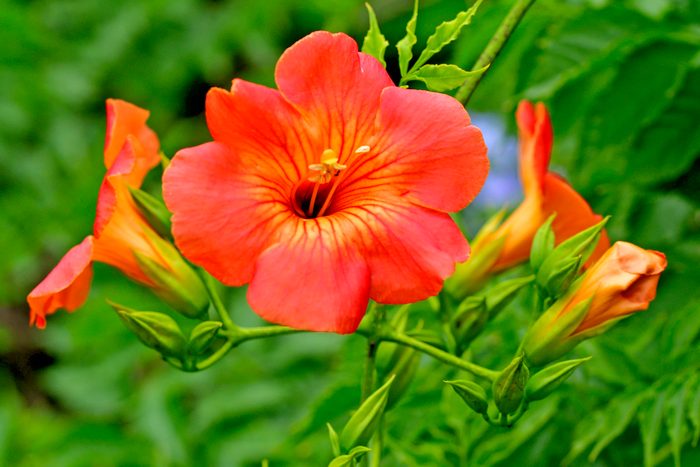
- Botanical name: Campsis radicans
- Other common names: trumpet creeper, devil’s shoestring, cow vine
- Growing zones: 4 to 9
- Size: Vining plant with stems up to 40 feet
- Light needs: Full sun to part shade
- Water needs: Medium
This fast-growing vine is quick to climb high up fences, trees, or other supports using its aerial rootlets. The shiny serrated leaves grow in leaflet pairs of three to six, and the waxy 3- to 4-inch long trumpet-shaped flowers that give it its name are red to reddish-orange. Cultivars like ‘Flava’ have yellow flowers instead. All parts of trumpet vine are mildly toxic, so wear gloves when handling and keep plants away from pets and children.
Horticultural expert Melinda Myers says, “Trumpet vines require patience. First and foremost, they need to reach maturity before they start blooming. This can take several years after planting. It’s important to avoid high nitrogen fertilizers, because they promote leaf and stem growth while also preventing flowering.”
Here are the top 10 vines to grow for hummingbirds.
Does Trumpet Vine Attract Hummingbirds?
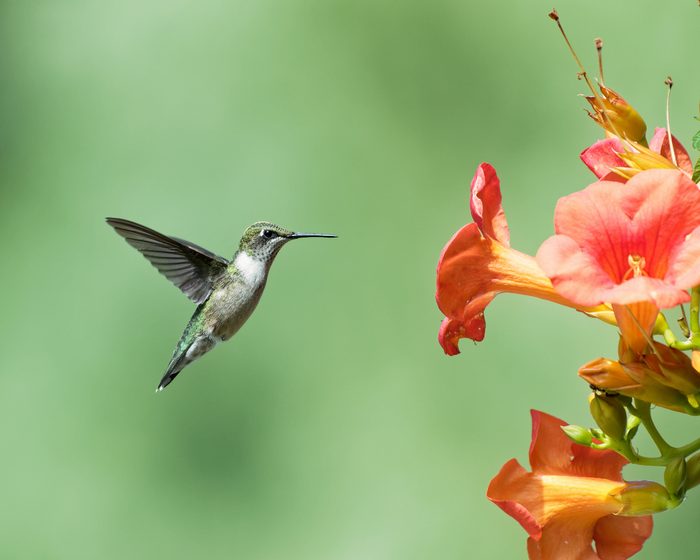
Those deep flowers hold sweet nectar at their base, drawing hummingbirds in to feast. These birds pollinate the plant, along with bees, butterflies and ants, among others. The leaves also serve as a host plant for the caterpillars of the Plebeian sphinx moth (Paratrea plebeja), too. That makes this blooming vine an all-around winner in a wildlife garden that has the space for it.
Did you know: Trumpet vine can offer hummingbirds up to 10 times more nectar than most plants.
Find more tube-shaped flowers that attract hummingbirds.
Where to Grow Trumpet Vine
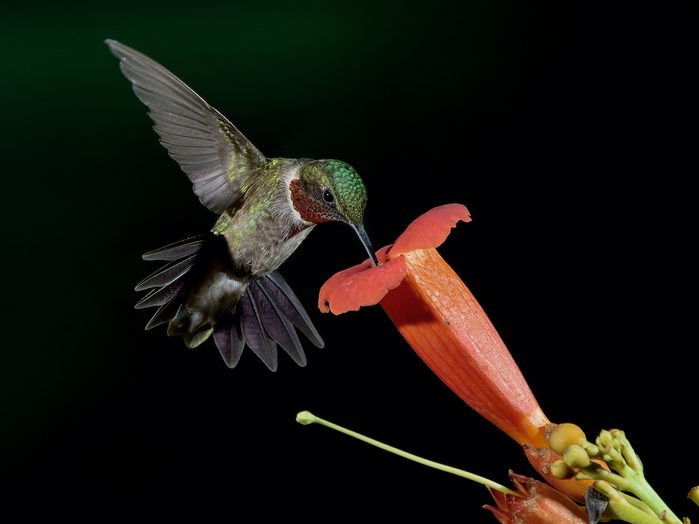
Like most vines, this one does best in a place where it can climb. At ground level, it tends to overtake everything around it, so give it a fence, trellis, or even tall tree to clamber up instead. It can also make a cool container plant, especially in hanging baskets where the trailing blooming vines really come into their own.
Trumpet creepers grow well in many soils, as long as they’re well-draining. It’s even drought-tolerant once established. Give it lots of sun to maximize flowering. Individual vines can stretch up to 40 feet long, so provide plenty of room for them to stretch and thrive.
One real advantage to this flowering vine is its deer-resistance. It rarely experiences serious pests and diseases, though powdery mildew and leaf spots can be occasional problems. Remove affected leaves as soon as you see them, and rake up leaf litter in the fall to minimize the issue the following season.
Psst—hummingbirds will also flock to a hummingbird mint plant.
Is Trumpet Vine Invasive?
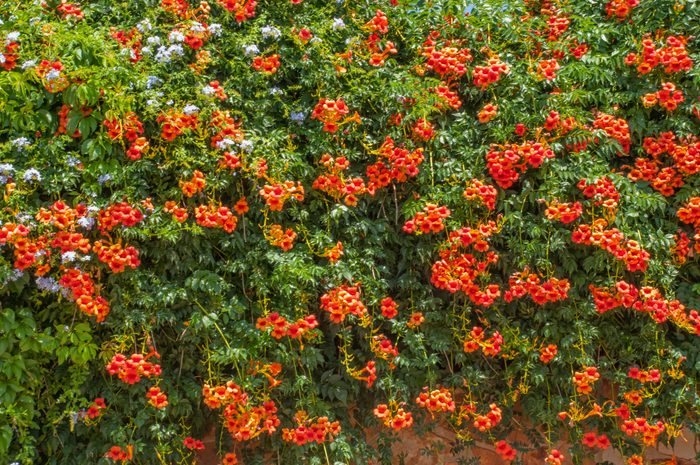
This wide-ranging plant is native or naturalized across most of the United States: north to New England and south all the way to Florida, and across the central plains into Kansas and Texas. It’s been planted as an ornamental hummingbird plant in many other places across the country.
Even in its native areas, trumpet creeper can quickly become unruly in smaller gardens or landscapes, taking over a space. The aerial roots can damage wood and stone, including on buildings. It may need regular pruning to keep it in check in many landscapes. Cut it back to the ground in early spring to encourage fresh, healthy growth. Then, prune throughout the growing season as needed, wearing gloves to avoid the mildly toxic sap the vines produce.
This vine also travels by roots underground, popping up many feet away from the original planting. Rooting it out can be difficult, so take care in planting it initially. If you have concerns about whether trumpet vine is right for your landscape, consult your local county extension office or a master gardener for advice.
Melinda says, “Though a real hummingbird magnet, the suckering characteristic is a big downside of this vine. Trumpet vine sends up runners that can be challenging to manage. Continually pruning the shoots to the ground as they appear will eventually starve the plant, but you must remove every one. As you discovered, it can take a lot of time and effort. Another option is you can paint the leaves with a total vegetation killer. If you do, be careful not to touch nearby desirable plants and know that repeat applications will be needed. As always, be sure to read and follow label directions.”
Next, learn how to grow nectar-rich native plants for hummingbirds across the country.
Why Trust Us
For nearly 30 years, Birds & Blooms, a Trusted Media Brand, has been inspiring readers to have a lifelong love of birding, gardening and nature. We are the #1 bird and garden magazine in North America and a trusted online resource for over 15 million outdoor enthusiasts annually. Our library of thousands of informative articles and how-tos has been written by trusted journalists and fact-checked by bird and garden experts for accuracy. In addition to our staff of experienced gardeners and bird-watchers, we hire individuals who have years of education and hands-on experience with birding, bird feeding, gardening, butterflies, bugs and more. Learn more about Birds & Blooms, our field editor program, and our submission guidelines.
Sources:
- https://www.missouribotanicalgarden.org/PlantFinder/PlantFinderDetails.aspx?kempercode=b840
- https://www.wildflower.org/plants/result.php?id_plant=cara2
- https://plants.usda.gov/DocumentLibrary/plantguide/pdf/pg_cara2.pdf
- https://www.butterfliesandmoths.org/species/Paratraea-plebeja
- https://portal.ct.gov/CAES/Plant-Pest-Handbook/pphT/Trumpetvine-Campsis
- https://edis.ifas.ufl.edu/publication/FP099
- Birds & Blooms official gardening expert Melinda Myers
You probably recognize common feeder birds by color. Red? Cardinal. Blue? Blue jay. Yellow? Goldfinch. But when all of those colors and more are on one bird, you’re looking at a painted bunting.
Meet more beautiful bunting bird species you should know.
On This Page
What Do Male and Female Painted Buntings Look Like?
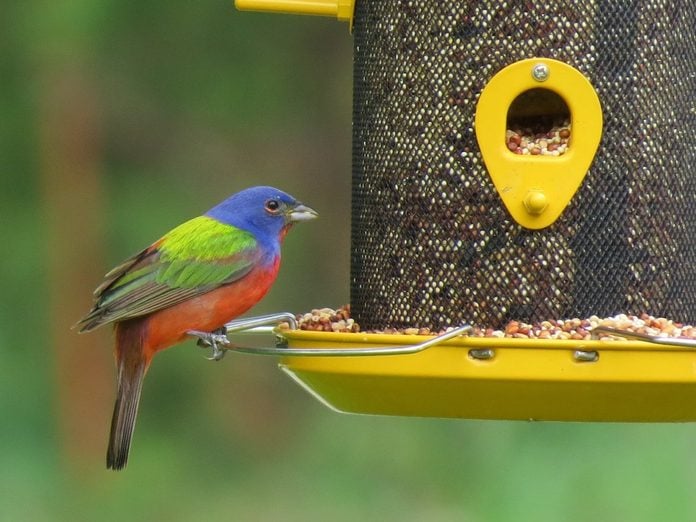
Males have bright blue heads, red bodies and yellow-green backs, with darker green on the wings. They develop this bold color in the fall of their second year.
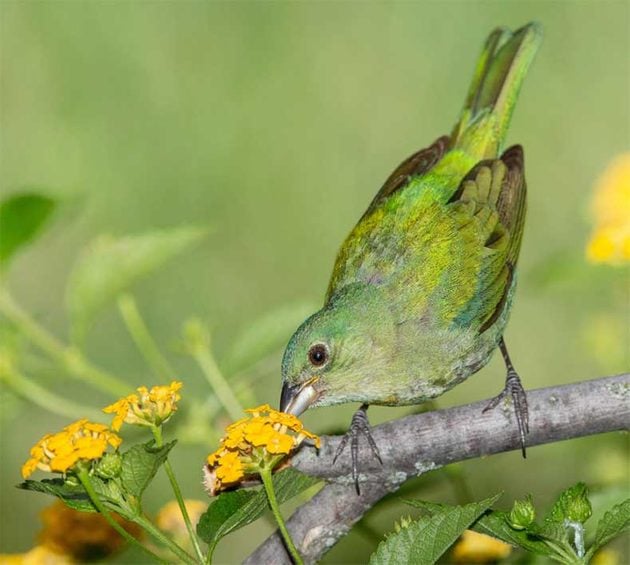
Females and juveniles sport a lime green hue, an unusual color among North American feeder birds.
Blue grosbeak vs indigo bunting: how to tell them apart.
Painted Bunting Nest
During the breeding season, males are extremely territorial. They stake out an area of about 3 to 8 acres and defend it vigorously from other males. Vicious fights may ensue, with males wounding other males. Females may even get caught up in the fray. Together the male and female choose a nest site, generally in dense vegetation about 3 to 6 feet off the ground.
Females build the nests and lay a clutch of three or four pale eggs speckled with brown, which they incubate alone for about 11 days. Once the eggs hatch, the female stays busy feeding her young brood, again with no help from her mate. The hatchlings fledge the nest in about nine days, and females often lay a second clutch of eggs soon after.
Learn how to identify a varied bunting.
Painted Bunting Song
Once the territory is secure, males sing and spread their feathers to attract a mate. Only male painted buntings sing songs like: graffiti graffiti spaghetti-for-two. If you think you see a plain green female bursting into song, it’s most likely an immature male in his first year.
Bird songs courtesy of the Cornell Lab of Ornithology
What Do Painted Buntings Eat?
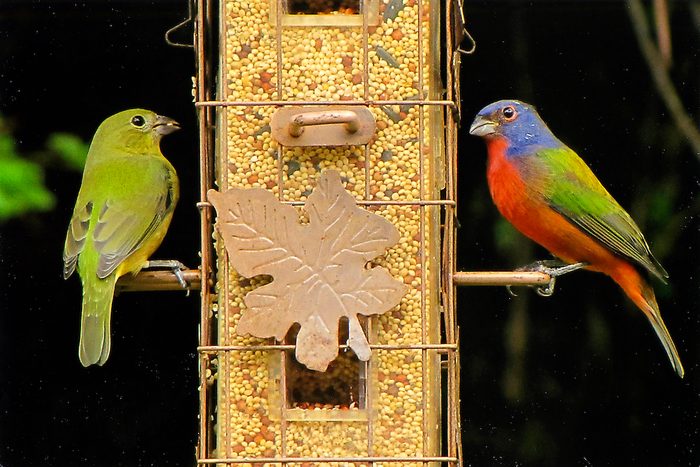
“Indigo buntings love the black oil sunflower seeds I put out. But their more colorful relative, painted buntings, do not. How can I attract them?” asks reader Kara Minter Petal, Mississippi.
Birding experts Kenn and Kimberly Kaufman say, “In terms of food, painted buntings are seedeaters. For those fortunate enough to have them on their list of yard birds, white millet seems to be the seed of choice. Birdbaths with moving water—a dripper or mister, for example— can also help entice these multicolored marvels to your yard.”
Painted buntings are wary and easily scared off, so hang a feeder with a protective cage around the tube to discourage larger bully birds.
During the breeding season, they switch to protein-heavy insects for extra energy. Females may steal bugs caught in spiderwebs, and even pull webs down to feast on the spiders that built them.
Once breeding season ends, they return to seeds, especially ones they find on or near the ground.
How to Attract Painted Buntings
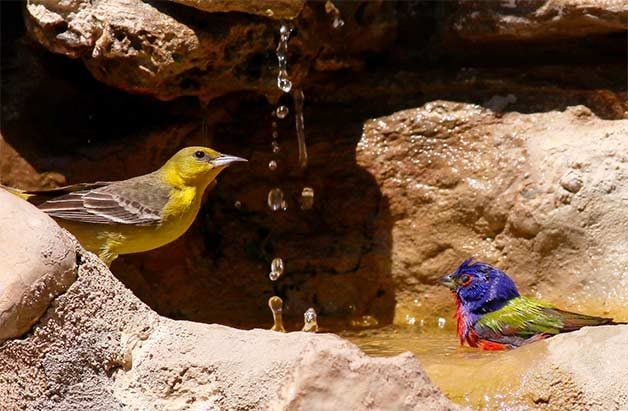
Kenn and Kimberly say, “You’d think a bird that looks like a feathered rainbow would want to be seen, right? But painted buntings can be shy and difficult to attract to backyards. For starters, they prefer habitat with a lot of cover, so areas with low, dense shrubbery are more appealing.”
Ensure that your yard provides the right habitat by planting plenty of native shrubs and grasses. Painted buntings nest close to the ground in low-growing vegetation, so having these on your property raise your chances of bringing in a breeding pair.
Painted buntings also like to have an easy source of water to visit.
Patience is the key with painted buntings. They may be slow to come around, but once they find a constant food source, water and protective shelter, they’re likely to return frequently.
Learn what snow buntings look like and where to find them.
Painted Bunting Range and Migration
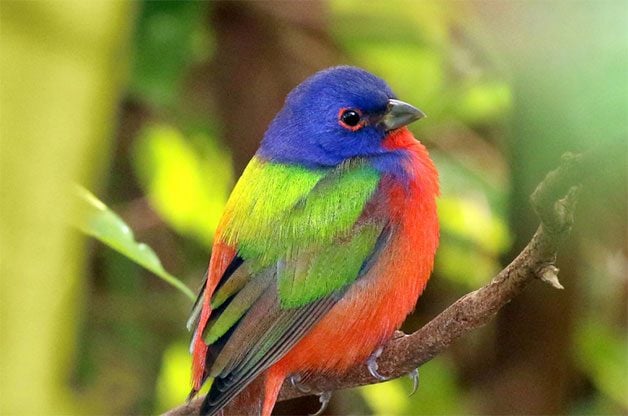
Look for painted buntings in the south central and southeastern states. They have two distinct summer breeding areas. One covers a large area from Texas to Mississippi and north to Kansas, and another is centered in the coastal Carolinas.
Painted buntings undertake a short winter migration to Florida, Mexico and Central America, when they gather in small mixed flocks with other birds, such as their indigo bunting cousins.
Editor’s note: Look for painted buntings in Florida. It’s the only state that consistently has a spring and summer breeding population and a winter population.
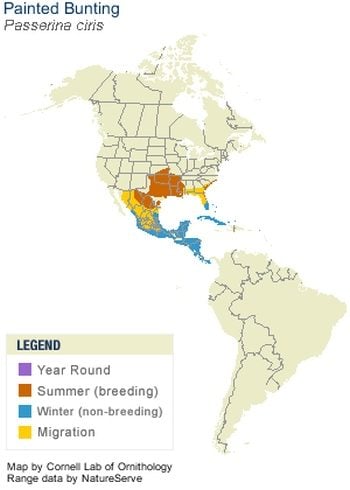
Next, learn about lazuli buntings: vibrant jewels of the west.
Why Trust Us
For nearly 30 years, Birds & Blooms, a Trusted Media Brand, has been inspiring readers to have a lifelong love of birding, gardening and nature. We are the #1 bird and garden magazine in North America and a trusted online resource for over 15 million outdoor enthusiasts annually. Our library of thousands of informative articles and how-tos has been written by trusted journalists and fact-checked by bird and garden experts for accuracy. In addition to our staff of experienced gardeners and bird-watchers, we hire individuals who have years of education and hands-on experience with birding, bird feeding, gardening, butterflies, bugs and more. Learn more about Birds & Blooms, our field editor program, and our submission guidelines.
Sources
- Kenn and Kimberly Kaufman, official birding experts for Birds & Blooms
- The Cornell Lab of Ornithology
On This Page
Questions About Feeding Hummingbirds
Hummingbirds are amazing creatures, with the ability to fly backward using wings that beat about 30 times a second. It’s no wonder people love attracting hummingbirds to their yards to enjoy them up close. Birding experts Kenn and Kimberly Kaufman answer some of your most frequently asked questions about feeding hummingbirds.
What’s the Recipe for Sugar Water to Feed Hummingbirds?
Mix four parts hot water to one part sugar. While some people don’t boil their water, it’s best to boil and then let it cool to room temperature to remove any impurities. Be sure to change out the sugar water every few days. You can store extra sugar water in your refrigerator for a week or more.
Should I Add Red Food Coloring to the Mixture?
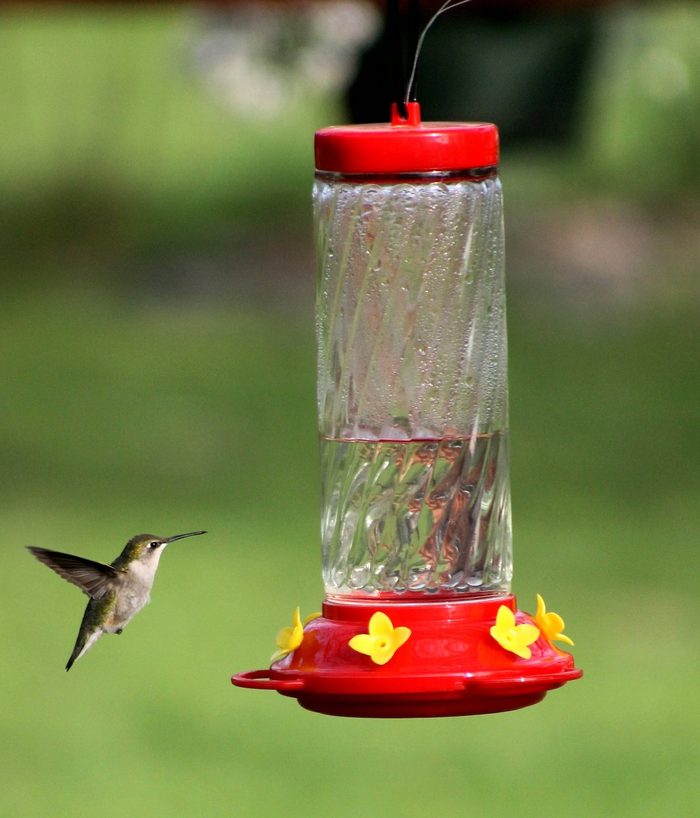
One of the older red food colorings was found to be toxic to birds, but with the new formulations, I don’t believe that’s still true. However, it isn’t necessary to add red dye or other ingredients to feed hummingbirds. The feeders usually have red parts, which provide enough color to attract hummingbirds. Stick to clear sugar water when feeding hummingbirds. You should steer clear of brown sugar, powdered sugar, honey and any other ingredient but plain white sugar.
Check out the best red hummingbird flowers to grow.
Is Organic Sugar Better for Hummingbird Feeders?
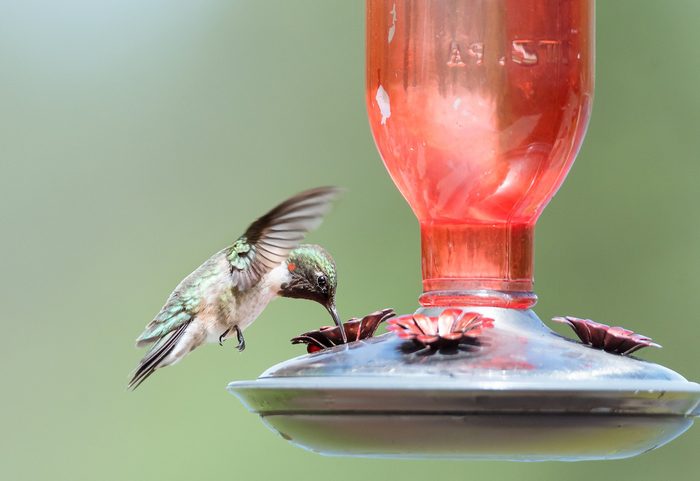
Pure white table sugar is the safest option for mixing nectar for hummingbirds. Many consider organic sugar, which doesn’t tend to be fully refined to pure sucrose, unsafe for feeding birds.
How Can I Prevent Mold Growth in Hummingbird Feeders?
“How do you keep homemade hummingbird nectar from getting moldy?” writes Birds & Blooms reader Della Lansdell of Prattville, Alabama.
We suggest mixing your own hummingbird sugar water, using 4 parts water to 1 part sugar, and bringing it to a full boil to break down the sugar completely. Once it’s cool, refrigerate what you don’t use between fillings. Avoid using red dye; the birds don’t need it, and it’s easier to monitor the freshness of colorless sugar water. Another way to avoid mold is to fill feeders only halfway and clean them before each refill. Placing your feeders in the shade will also help keep sugar water from spoiling too quickly.
What Are the Best Feeders for Hummingbirds?
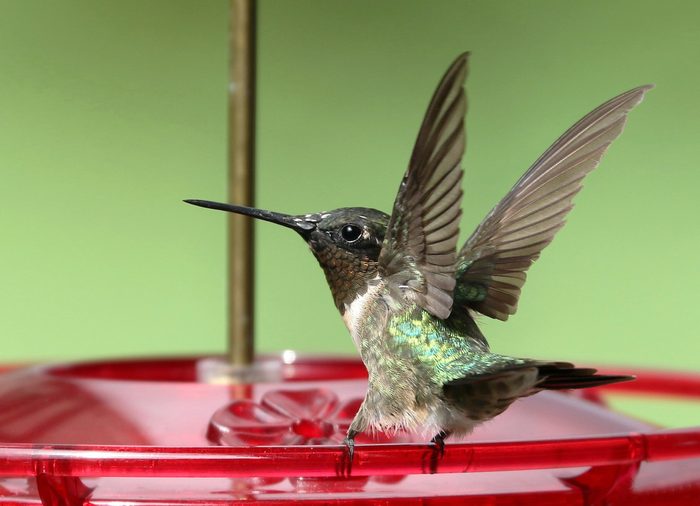
For the most part, hummingbirds aren’t picky, so the best feeder is the one you find easiest to fill, clean and hang. The traditional glass bottle that threads into a plastic basin works extremely well. We prefer the 30-ounce bottle because it’s more stable and doesn’t tip as easily when orioles drink from it. We also like the type with a shallow plastic basin where the lid with feeding ports snaps down over it. Both are easy to clean, and that is important.
Learn how to clean hummingbird feeders.
When Should I Hang My Hummingbird Feeders?
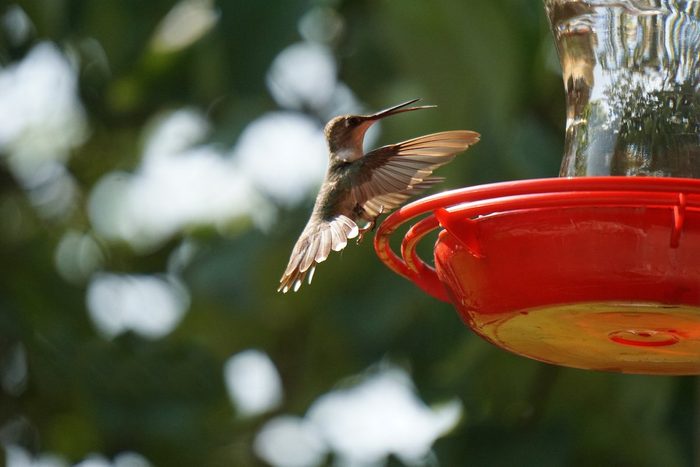
Early May is a good time to hang up your hummingbird feeders. In the South, migratory hummingbirds begin tapping sugar water feeders in backyards in early April. The funny thing about it is that if you don’t get them up early enough, the hummingbirds will often remind you by returning to the spot where the feeders were last summer and hover there looking for them.
Where Should I Hang Hummingbird Feeders?
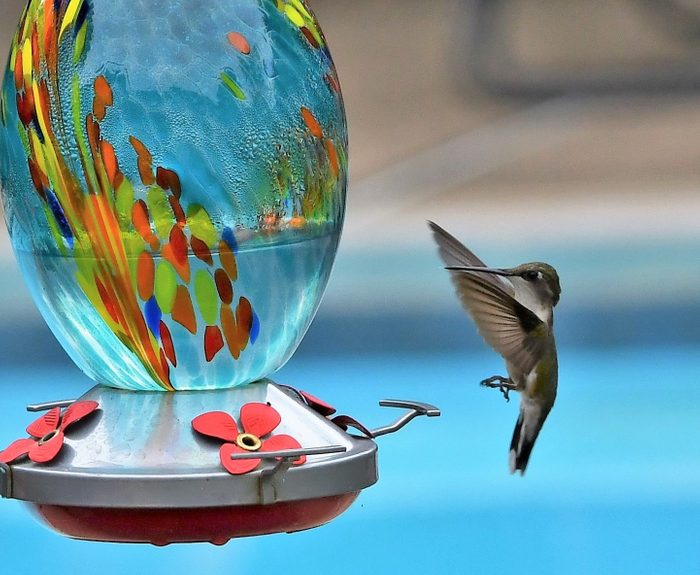
Since they’re accustomed to hovering low in front of flowers, there’s no real height requirement for hummingbird feeders. Just make sure the feeder is in a place where it’s easy to see and enjoy! This will allow you to monitor it closely for filling and cleaning, too.
Are Hummingbirds Territorial at Feeders?
“I never get more than one hummingbird at a time at my feeders. How can I encourage them to share?” asks reader Cheryl Vandermark of Wallkill, New York.
Hummingbirds have an instinct to protect their food sources, because in nature, a patch of flowers will produce only so much nectar in a day. The tiny birds carry this defensiveness over to artificial feeders. The best way to keep one hummingbird from dominating a feeder is to put up several feeders in different spots. If some feeders can be out of sight from the others (around a corner, for example), it will be even harder for one bird to control them all. With multiple feeders available, even the most aggressive hummingbirds may give up and just share with others.
Do fighting hummingbirds ever hurt each other?
I’ve Planted a Hummingbird Garden, but Why Don’t They Visit?
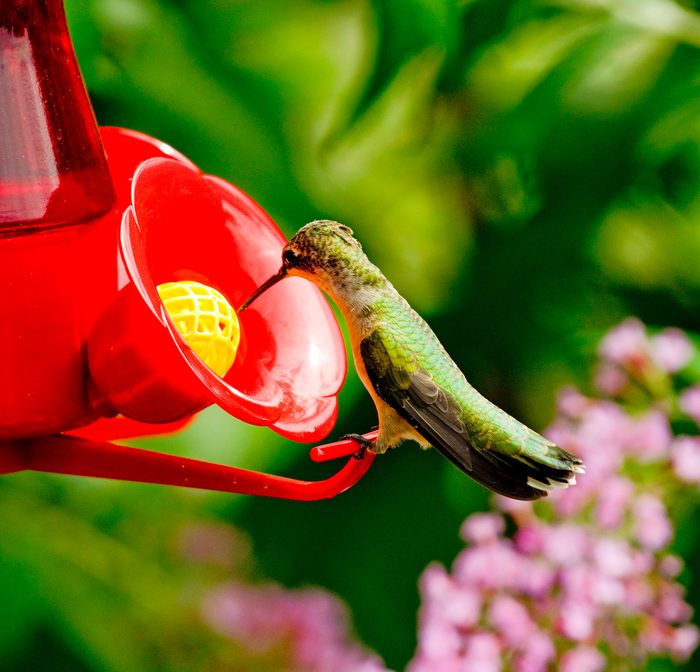
Try placing a hummingbird nectar feeder close to or among the colorful hummingbird flowers in your garden. This should create a target area for the birds and make attracting hummingbirds to your garden much easier.
Is It Better to Plant Flowers for Feeding Hummingbirds?
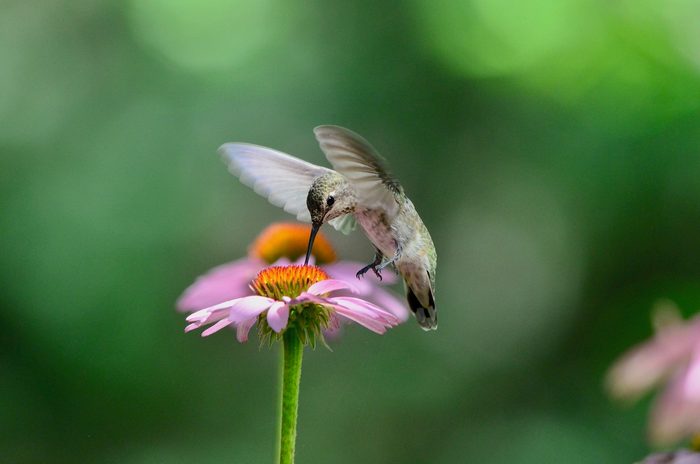
If we had to choose one over the other, we’d vote for planting flowers because they have many other benefits. A flower garden with a focus on native plants, full of a variety of species chosen to bloom throughout the warmer months, will sustain butterflies, bees and other pollinators. The tiny insects feeding on the plants’ leaves will in turn feed warblers and other songbirds.
But we think it’s ideal to have both flowers and feeders. A sugar-water feeder can be placed where it’s easy to watch, and it can help keep hummingbirds faithful to the yard during lulls in the garden’s blooming activity.
Learn how to attract hummingbirds to your small garden.
Will Hummingbirds Become Dependent on Feeders?
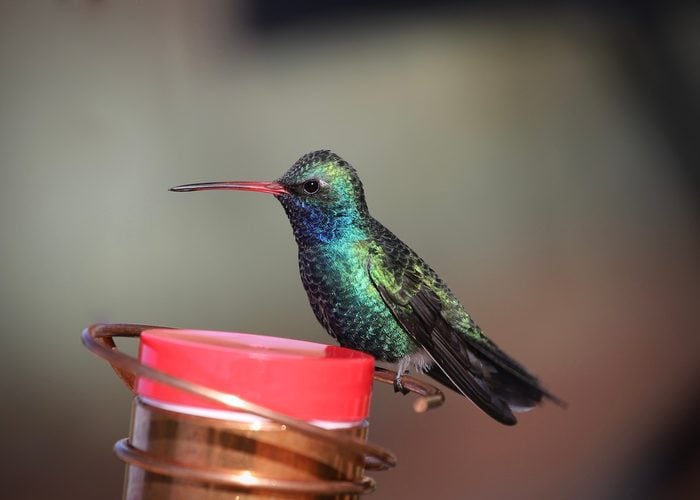
“We’re selling our house, and I’m concerned the new owners will not keep the hummingbird feeders filled. What will happen?” says reader Vincent Staley of Fredericksburg, Virginia.
We appreciate your concern, but hummingbirds are adaptable and good at finding new places to live. In natural habitats, good concentrations of flowers may change over time. For example, a meadow filled with flowers one year may be overgrown with shrubs the next. Hummingbirds have to be able to move around and find new food sources. Of course, if you can talk to the new residents of your home, you could try to inspire them with stories about feeding hummingbirds and tell them the rewards of keeping the feeders filled and clean.
Here’s how to create an ideal hummingbird habitat.
How Can I Keep Yellow Jackets Off Hummingbird Feeders?
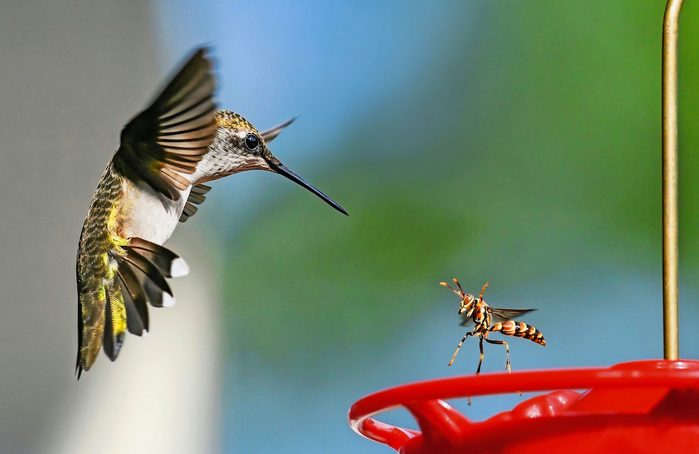
“How can I keep yellow jackets away from my hummingbird feeders? asks reader Gail Mitchell of Martinsville, Virginia.
Reducing the ratio of sugar to water might help. Try 5 parts water to 1 part sugar, instead of the usual 4 to 1. Be sure to clean any spillage off the feeding ports. Since bees and wasps prefer to feed in sunny areas, you could try moving your feeders to a shadier area. Avoid using products such as pesticides, petroleum jelly or cooking oil on the feeding ports to discourage bees and wasps, since these substances can be deadly for hummingbirds. It’s also good to remember that these insects are important pollinators, and we should protect them, too.
Check out more natural ways to keep wasps away from hummingbird feeders.
Do Bees Make Hummingbird Feeders Dirtier?
“I have several sugar-water hummingbird feeders. Bees invade some of them. When I bring in the feeders for cleaning and refilling, the ones used by bees are usually dirtier. Why?” asks reader Ellen Gonzales of Dripping Springs, Texas.
It’s hard for us to be sure without actually seeing the feeders involved, but we have some ideas. Bees only visit feeders where the sugar water is easy to reach—especially if it’s leaking or spilled on the outside. Even a very slow leak can make the feeders dirtier inside and out. Bees often carry pollen, and they may leave a light dusting of it on every visit to the feeder, adding to the mess. Check your feeders carefully for leaks, install bee guards on the openings, and consider switching to the dish feeder style in which the openings are raised well above the level of the sugar water.
Use an ant moat to keep ants off of your hummingbird feeders.
How Do Hummingbirds Feed Their Babies?
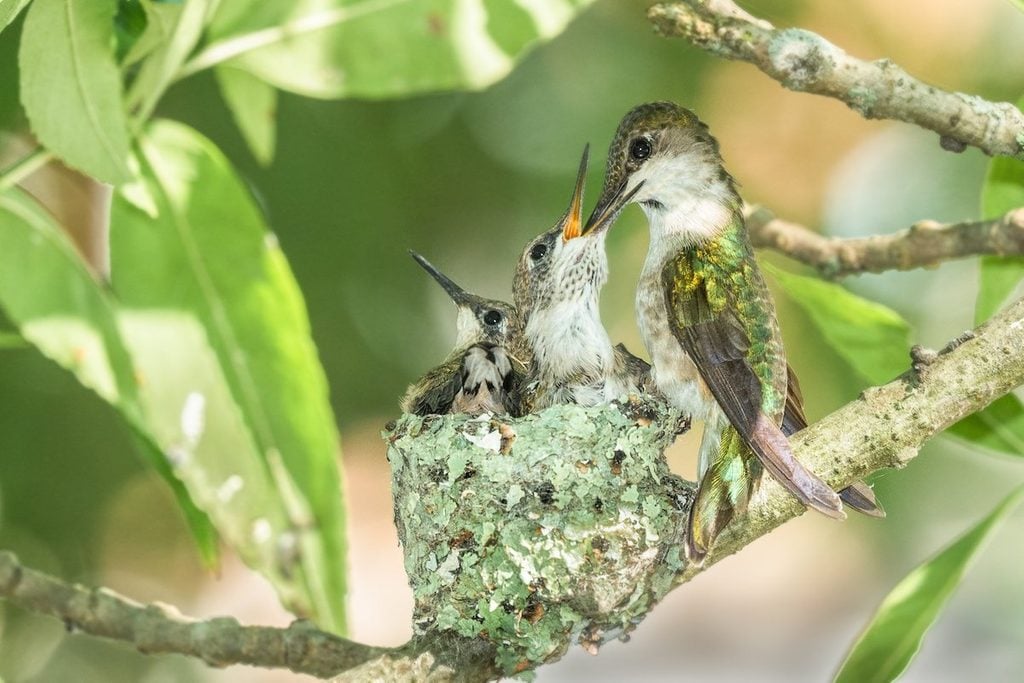
Hummingbirds usually feed tiny insects and spiders to their young. They insert them right into the mouths of their baby hummingbirds. They’ll also feed nectar and pollen to the young birds. They do this by holding it in their throats and then squirting it into the mouth of the nestlings. Sometimes this will cause the youngster’s throat to swell temporarily, resembling a goiter.
Here’s everything you need to know about hummingbird nests.
How Do Hummingbirds Drink Nectar?
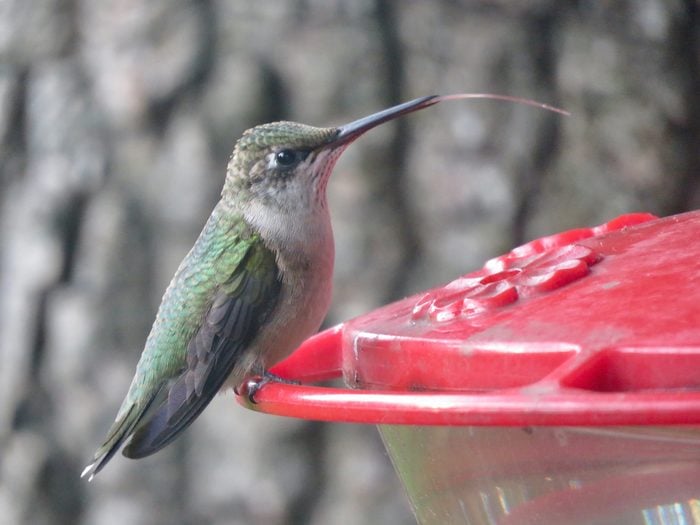
This is a bit of a tricky one. Hummingbirds seem to use their tongues in a way that scientists never expected —a hummingbird tongue’s tubes open down their sides when they insert it into a flower or feeder. When they pull the tongue back in, the tubes zip closed around the nectar, bringing it back into the bird’s mouth. They are one of the few species of birds that swallow liquid without throwing their head back to allow gravity to help them swallow.
Hummingbird sounds: do hummingbirds sing?
I Saw a Yellowish Hummingbird at My Feeder. Is This Common?
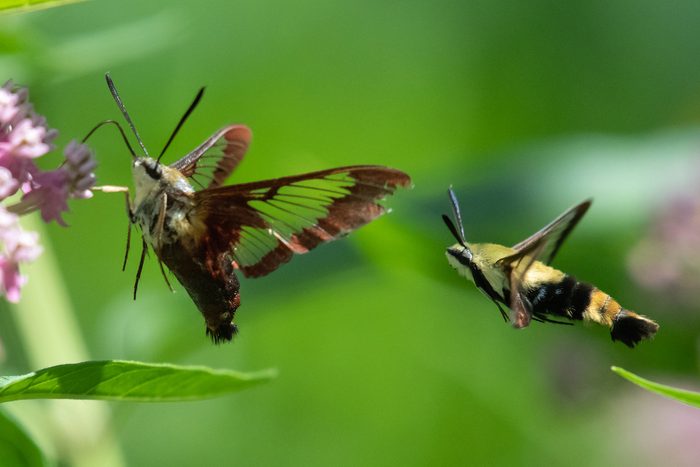
Though rare, some bird species will produce a yellow version of themselves, such as yellow cardinals. This condition is called xanthochroism, an abnormal yellowing of the plumage. It is thought to be caused by a loss of dark pigment (melanin) in the bird’s feathers. If the mystery visitor was much smaller than a hummingbird, it could be a sphinx moth, also called a hummingbird moth. This is a diurnal moth (meaning it’s out during daylight), and one variety is yellow in color and common in gardens in the summer.
What makes hummingbird feathers so shimmery?
Why Do Hummingbirds Hang Upside-Down From Feeders?
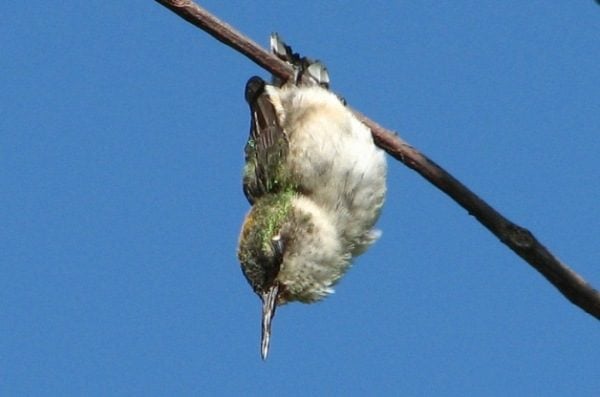
“I saw a hummingbird hanging upside down from my sugar-water feeder by one foot. As I neared, it flew away. What happened to it?” says reader Margaret Hocker of Metropolis, Illinois.
Hummingbirds have a bizarre way of conserving energy. Usually at night, during periods of cold and sometimes when they’re perched at a feeder, hummingbirds can enter a deep, sleep-like state known as torpor, when all body functions slow dramatically. Metabolism slows by as much as 95%, and heart rate and body temperature drop significantly. Torpor allows them to conserve precious energy and survive surprisingly low temperatures. Hummingbirds are tough birds! If you see a hummingbird in such a state, there is no cause for concern.
Where do hummingbirds sleep at night?
Why Do I Never See Male Hummingbirds at My Feeders?
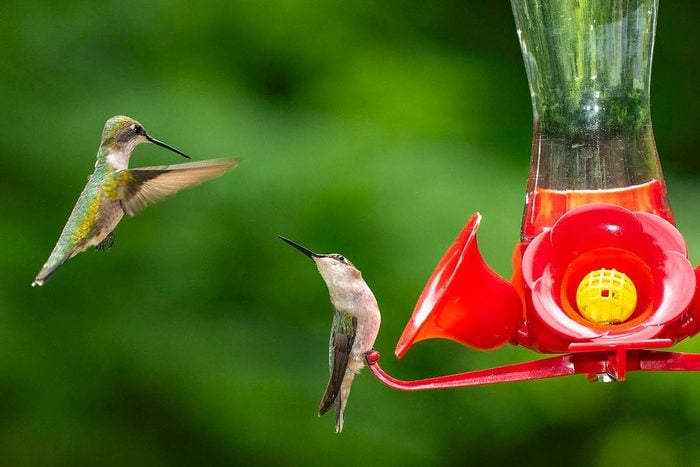
“I only have female ruby-throated hummingbirds visiting my sugar-water feeder and the flowers on my deck rail. I never see males. Do they like different flowers and the types of feeders than the females? asks reader Linda Anderson of Berwick, Pennsylvania.
Males and females generally like the same things, so there may be other factors at work here. It’s possible that the male hummingbirds in your area have territories away from your feeders and flowers so you don’t see them as often. We’ve also seen females defending the territory around the nest, actively chasing off the males and other females that venture too close. Also, remember that juvenile hummingbirds (both males and females) look like the adult females, so they outnumber the flashy ruby-throated adult males.
How Can I Help Hummingbirds Fuel Up for Migration?
Hummingbirds store enough fat to allow them to cross the Gulf of Mexico. In fact, they begin this storage before they even leave their nesting grounds. You may notice that in late summer, just before they begin to migrate south, hummingbird behavior changes a bit and they eat more food more often. They stop to feed along the way, too, and store as much energy as possible. That’s why it’s important to maintain sugar water feeders at least through September, even after hummingbird activity subsides.
Add a bird bath for hummingbirds to your yard.
Why Do Finches Visit Hummingbird Feeders?
“Is it normal for house finches to drink sugar water?” writes reader Shannan Shade of Marshall, Wisconsin.
Although hummingbirds are the only true nectar specialists in North America, many birds sample the sweet stuff when they get the chance. Once they learn to drink from hummingbird feeders, house finches may become regular visitors. Other examples of surprising visitors include titmice, several warblers (including Cape May, pine and orange-crowned), goldfinches, mockingbirds, chickadees, and thrashers. Aside from birds, your sugar water feeders also may attract nectar-feeding bats (in the Southwest), squirrels, and even bears if there happen to be any in your neighborhood.
Is that a woodpecker at a hummingbird feeder?
How Can I Keep Orioles Away from Hummingbird Feeders?
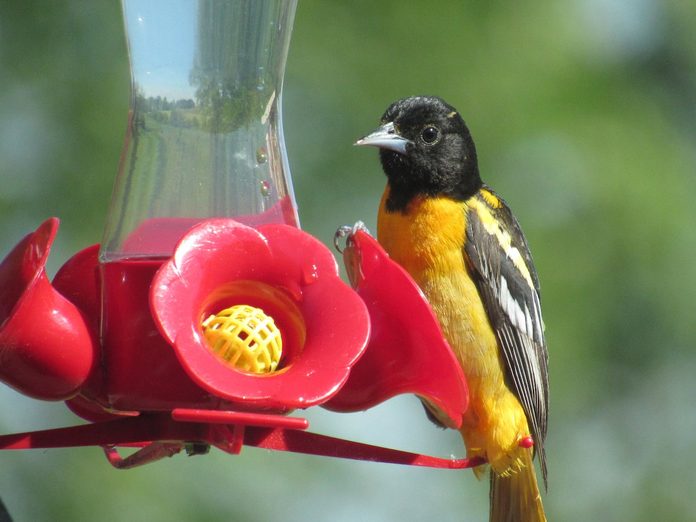
“How can I keep larger birds like orioles from monopolizing my hummingbird feeders?” says Roger Hatfield of Del Rio, Texas.
In your region of Texas, you’re lucky to have several types of orioles, but we understand why you’d want to keep space open for feeding hummingbirds. One approach is to have one or two “sacrificial” feeders, with perches that make it easy for orioles and other larger birds to drink sugar water. If you have other feeders with no perches, the hummingbirds can still hover at those to feed, ideally undisturbed by the larger birds.
Contributing writer and birding expert: George Harrison
Why Trust Us
For nearly 30 years, Birds & Blooms, a Trusted Media Brand, has been inspiring readers to have a lifelong love of birding, gardening and nature. We are the #1 bird and garden magazine in North America and a trusted online resource for over 15 million outdoor enthusiasts annually. Our library of thousands of informative articles and how-tos has been written by trusted journalists and fact-checked by bird and garden experts for accuracy. In addition to our staff of experienced gardeners and bird-watchers, we hire individuals who have years of education and hands-on experience with birding, bird feeding, gardening, butterflies, bugs and more. Learn more about Birds & Blooms, our field editor program, and our submission guidelines.
On This Page
Why You Should Make Plant Cuttings
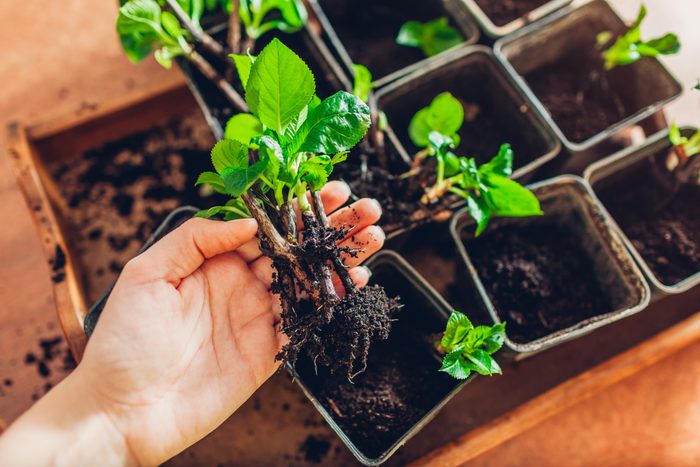
Growing plants from cuttings is a great way to expand—or share—the beauty of any garden. Perhaps you’d like to preserve a flower with family history, increase your collection of favorite blooms or reproduce that hard-to-find plant. Most gardeners have had success rooting leafy plants like coleus or philodendron. A short stem with leaves will quickly form roots in water, potting mix or vermiculite—and then you are well on your way to a full-sized plant.
The same does not hold true for trees and shrubs, however. With these woody plants, you’ll need to pay more attention to timing and the type of cutting you take. And these factors will vary depending on the type of plant. But with a little practice, you’ll soon know how to root cuttings of woody plants like roses, lilacs, forsythias and spireas. The extra effort will be worth it.
Check out the top 10 plants to grow from plant cuttings.
Types of Rooted Woody Plant Cuttings
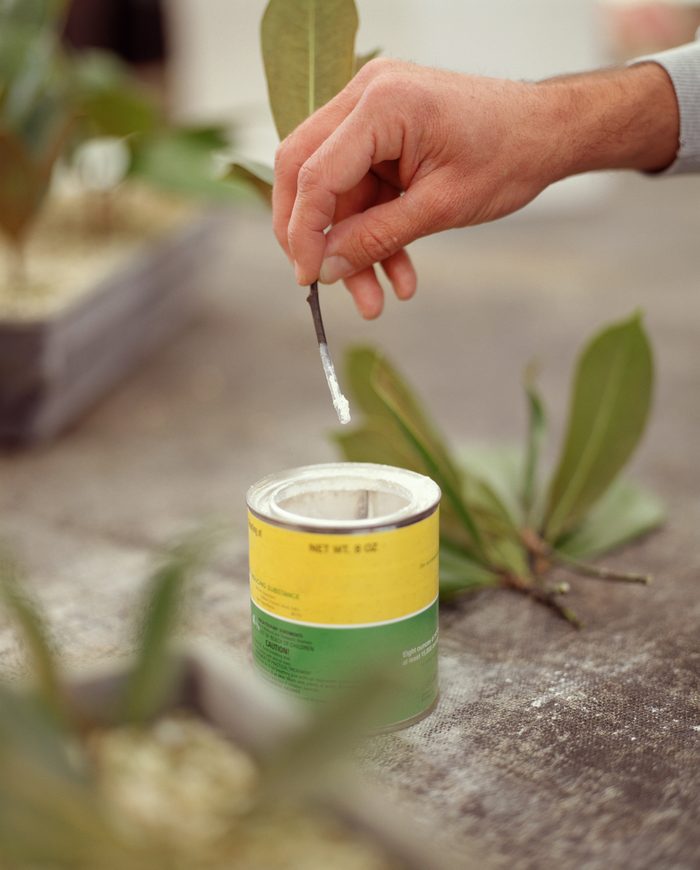
There are several types of rooted plant cuttings you can use to propagate new trees and shrubs. Learn more about plant propagation to multiply your plants for free.
Hardwood plant cuttings
These are the key to starting plants like roses, forsythia, privet, olive, wisteria, spirea, hemlock and many other deciduous and needled trees and shrubs.
During the dormant season, which is late fall or winter, remove a 4- to 8-inch stem piece of the previous season’s growth that contains two nodes—the place where leaves attach. Pack the cuttings in peat moss or sawdust and store them in a cool dark place until spring. As the weather warms, stick the cuttings—with the end that was closest to the roots down-in a flat of moist vermiculite, perlite or sand. To increase the success for these types of cuttings, or any others, dip the end in rooting hormone first.
Semi-hardwood plant cuttings
Summer is the time to take semi-hardwood cuttings—the new growth that’s starting to harden up and mature. This works for varieties like holly, azaleas, pittosporum, euonymus, citrus, olive and other broadleaf evergreens and deciduous trees and shrubs.
Take 3- to 6-inch cuttings in the morning when the stems are firm and full of moisture. Remove the lower leaves and cut the remaining leaves in half to reduce moisture loss.
Then root semi-hardwood cuttings in moist vermiculite, perlite or sand in a shaded and humid location. Loosely cover the container with plastic to increase the humidity and monitor the temperature to prevent overheating.
Softwood cuttings
Softwood cuttings from tender new growth are another way to propagate plants like lilacs, roses, forsythias, magnolias, weigela, spireas and fruit trees.
Take 3- to 5-inch cuttings early in the day and plant them right away for the best results. Root in a warm and moist rooting medium in a humid location that’s out of direct sun.
Expert Tips for Making and Rooting Plant Cuttings
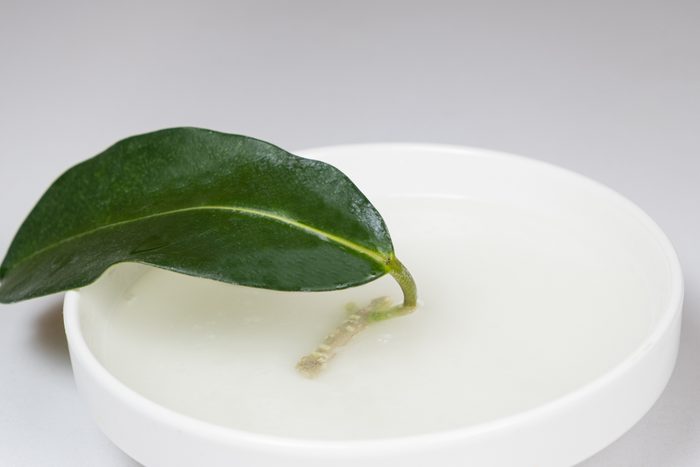
- It’s best to take cuttings from recently watered plants. The cuttings will be healthier when taken from plants that are full of moisture.
- Make sure you have a clean, sharp knife or a good pair of pruning shears handy to make the cuts.
- Take cuttings only from healthy plants. Make sure the parent plants are disease- and pest-free. Early morning is the best time to take cuttings.
- Not all plant cuttings will root at the same speed, so if one plant takes 10 days and another takes 20 days, don’t be alarmed.
- Be prepared for this process to fail from time to time. And don’t be afraid to experiment with other plants, just to see what happens.
No matter what kind of cuttings you’re using, once they’ve rooted, you can treat them like bare-root plants and add them to your garden. Or, move them to a large container filled with well-draining potting mix. This allows the plants to develop stronger root systems before transplanting.
Learn how to propagate succulents.
Pay Attention to Patents
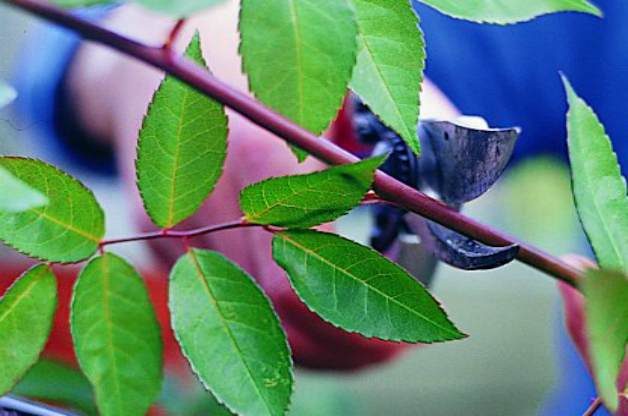
Before you take a cutting of that fancy new rose or lilac, it’s important to understand some of the laws related to the plant world.
Many new varieties are patented. This means you cannot take a cutting from an existing plant to start a new one without the permission of the patent owner. This right is reserved for the company that spent time and money developing the new or unusual variety. If this is the case, a close look at the tag or growing information will reveal a patent number or note that the patent is pending.
Patents are good for about 20 years. After that, you are free to take cuttings and start your own plants. Although it may seem like an inconvenience, remember that respecting the patents helps support those who work to introduce new plants for us to enjoy.
When checking the tag, you also may see ® or copyright symbols. You can take cuttings and plant these varieties in your garden, as long as they are not patented.
If all this sounds too confusing, don’t be intimidated. There are plenty of old family favorites and traditional garden beauties that aren’t protected—and these make great candidates to grow from cuttings.
As you begin trying to grow trees and shrubs from cuttings, I do have some last words of wisdom: Professionals often spend years perfecting this process, so don’t be disappointed if your cuttings don’t root right away. Just keep trying, and soon you should have new plants to show off for your efforts.
Next, get expert tips on how and when to prune lilacs.
Why Trust Us
For nearly 30 years, Birds & Blooms, a Trusted Media Brand, has been inspiring readers to have a lifelong love of birding, gardening and nature. We are the #1 bird and garden magazine in North America and a trusted online resource for over 15 million outdoor enthusiasts annually. Our library of thousands of informative articles and how-tos has been written by trusted journalists and fact-checked by bird and garden experts for accuracy. In addition to our staff of experienced gardeners and bird-watchers, we hire individuals who have years of education and hands-on experience with birding, bird feeding, gardening, butterflies, bugs and more. Learn more about Birds & Blooms, our field editor program, and our submission guidelines.
On This Page
How Do Birds Use Their Feet?
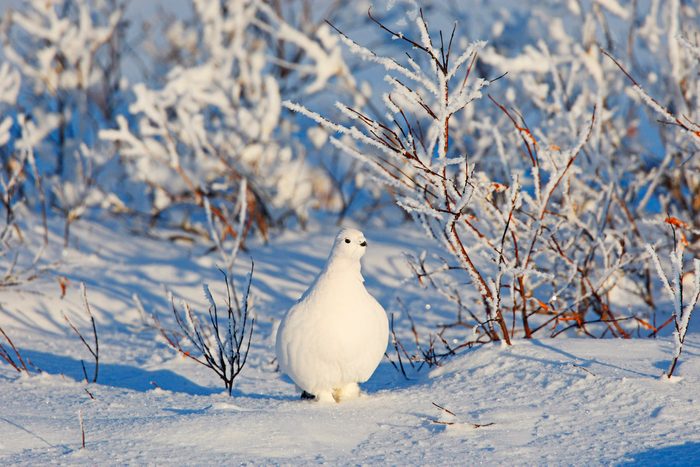
As bird lovers, we spend a lot of time in awe of birds for their brightly patterned plumage, wing shapes and entertaining antics, not to mention that they can fly. But when not soaring through the sky, birds rely on their specially structured feet to get around. Their unique toes come in arrangements such as zygodactyl and anisodactyl, which may sound more like names of their dinosaur cousins, but don’t worry! You can still appreciate just how crucial birds’ feet really are. No scientific memorization required!
Learn all about hummingbird feet: can hummingbirds walk?
Bird Feet and Toes for Perching
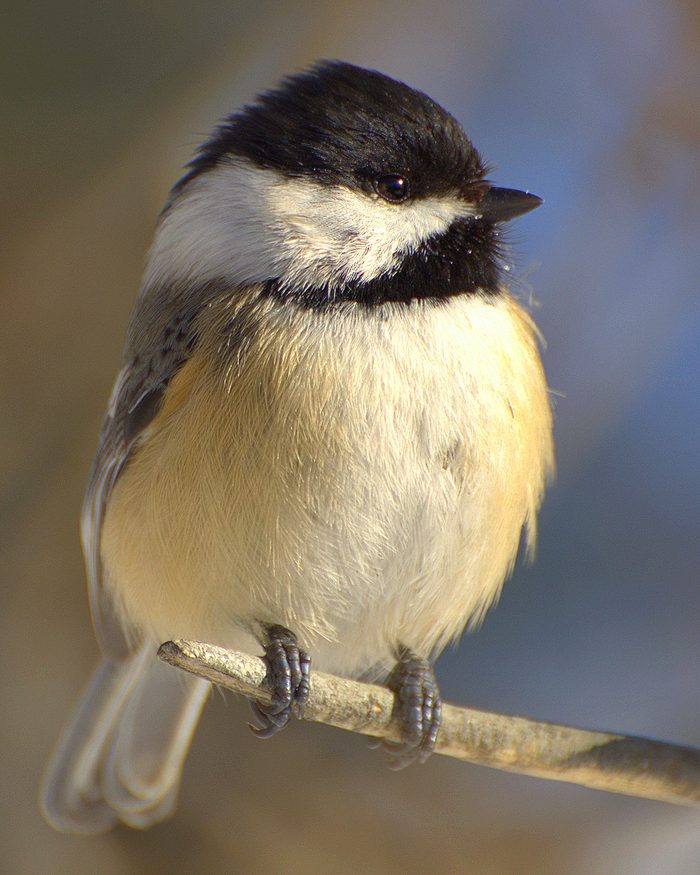
Many backyard birds, from robins to wrens and phoebes to finches, belong to a large group called perching birds. The structure of their feet helps them perch on thin twigs. These birds have three toes pointing forward and one pointing backyard, an anisodactyl arrangement, so each foot touches the perch at four separate points.
When birds settle on a twig, their toes automatically tighten, thanks to the muscles in the legs and feet. Similarly, when birds rise up, the toes loosen their grip. Chickadees that flit from branch to branch may grasp and release different perches thousands of times a day.
Bird anatomy 101: here’s what you need to know.
Bird Feet for Climbing Trees
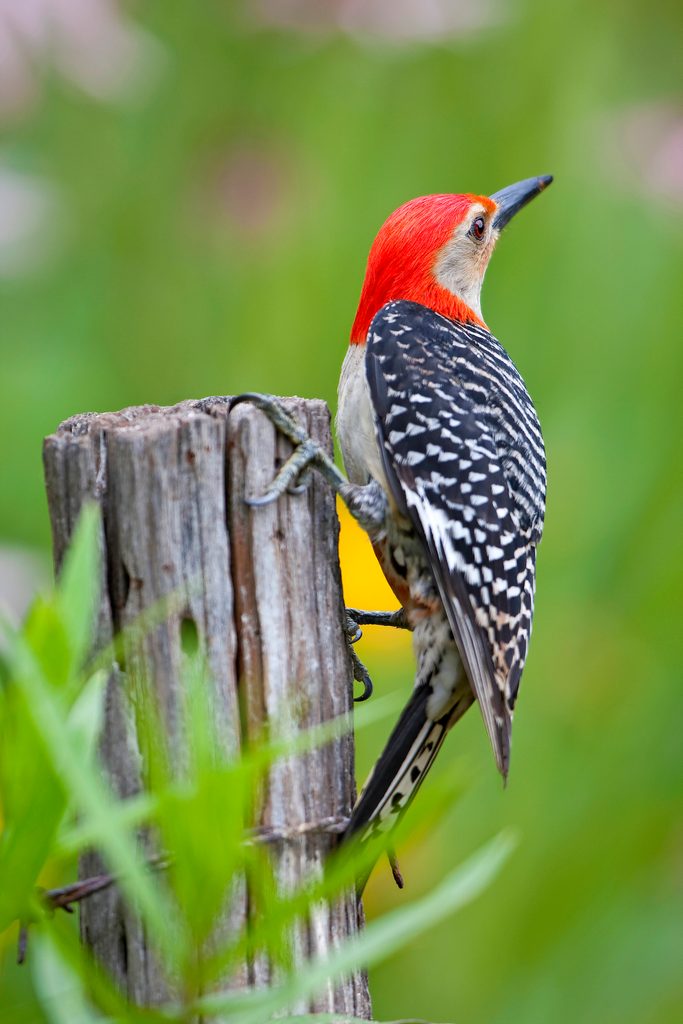
Woodpeckers, nuthatches and creepers are common tree-climbing birds. Their powerful gripping toes help them cling snugly to bark or dead wood.
Learn all about bird wings and flight feathers.
Bird Feet and Toes for Walking
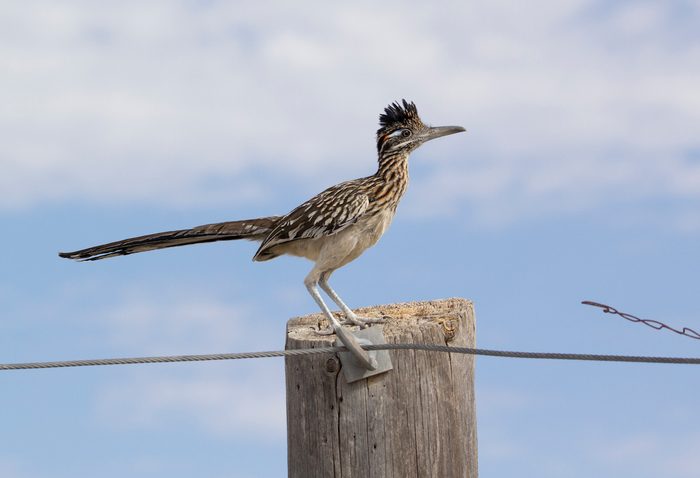
Wild turkeys and ring-necked pheasants walk more than fly, and have strong, sturdy legs and toes. Males of both species have a spur on the back of the leg, which they may use when they get into fights. It’s typical for birds that spend a lot of time on the ground, especially hard ground, to have strong feet.
Another bird known for strong legs is the greater roadrunner of the desert Southwest. This bird has zygodactyl feet (two toes pointing forward and two backyard). It leaves X-shaped tracks, and Native American legends celebrated the fact that no one could tell from the tracks which way the bird was going. True to its name, the roadrunner can run at 20 miles per hour for quite a distance.
The ultimate walking bird is probably the ostrich, the tallest bird in the world. Its small wings are useless for flight, but it has huge, muscular legs and feet. While most birds have four toes and a few have three, ostriches are the only birds in the world with only two toes on each foot.
Learn about 6 bird beak types and how birds use them to eat.
Bird Feet for Swimming
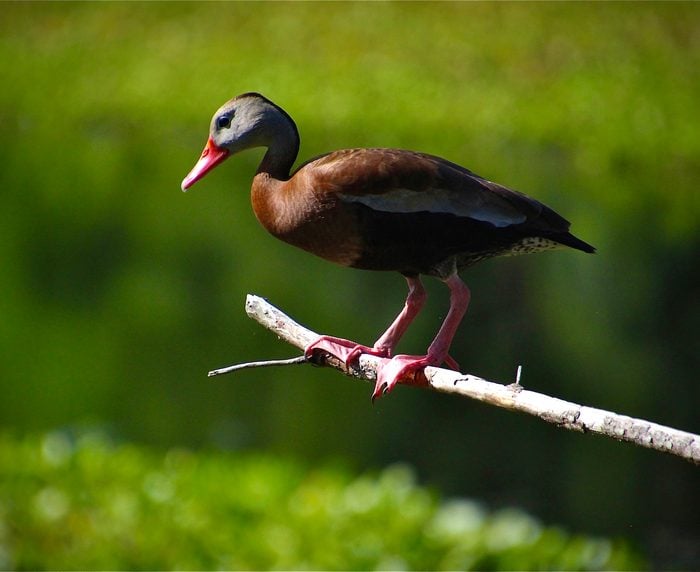
Birds that swim have special requirements. They paddle with their feet to move across the water’s surface, but the skinny little toes of a typical bird wouldn’t be useful for pushing against water. However, with webbing stretched between the toes, those feet become very effective fins. The webbed feet of ducks, geese, and swans are widely known, but we also see webbed feet on many unrelated waterbirds, such as pelicans, loons, and gulls.
Some waterbirds have only partial webbing, often in the form of expanded lobes or flaps along the edges of the toes. The bizarre feet of the American coot offer an interesting example. Those lobed toes are good for swimming, and they’re also suited for walking on land. However, grebes rarely come out on land, and they also have lobbed toes.
Bird Feet and Toes for Uneven Surfaces
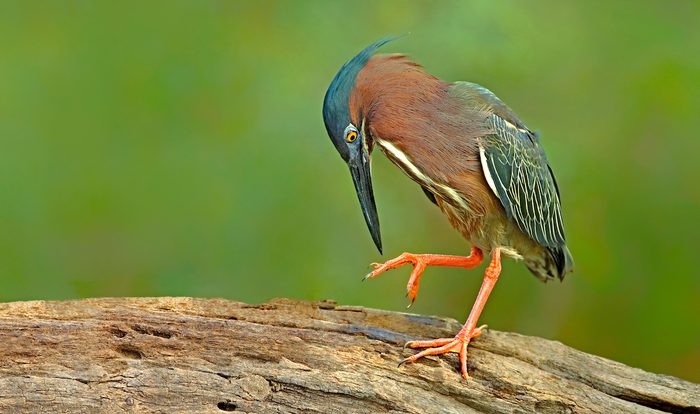
Birds can’t walk on water; but some marsh birds come close, with long toes that allow them to traipse across the surface of very wet mud or floating plants. We see this long-toed shape on various herons, rails, and sandpipers. The extreme examples are found on tropical shorebirds called jacanas. Their ridiculously long toes allow jacanas to walk around easily on top of floating lily paps. In fact, “lily-trotter” is one nickname for them. One species, the northern jacana, shows up in southern Texas at times.
What about walking on frozen water? Ptarmigan are small grouse that live in the far north and high mountains, regions covered with deep snow for much of the year. Like other grouse, they have fairly short toes. But ptarmigan grow a fringe of stiff feathers along the sides of their toes, which act like snowshoes, allowing them to walk across the surface of soft, fluffy snow.
Bird Feet for Feeding
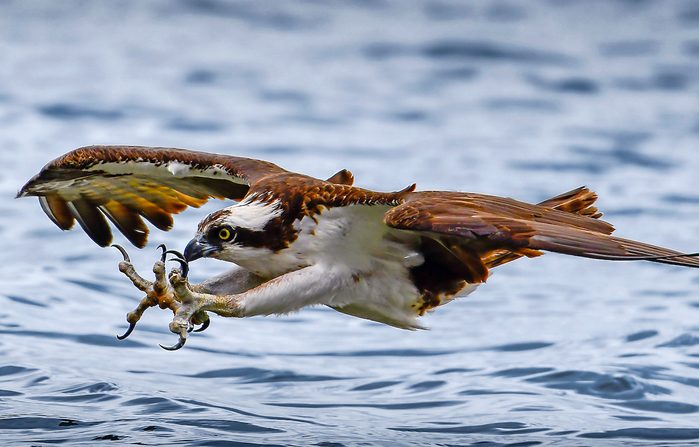
The word “raptor” comes from a root word that means “to seize and carry away.” Hawks, falcons, and owls have strong toes and long, sharp, curves claws, specialized for hunting, capturing, and carrying prey. Most birds use their feet for sitting in one place or moving around, but for these birds of prey, their feet are their essential tools.
Most hawks and falcons have three forward toes and one back toe. On owls, however, the outer toe is reversible: It usually swivels to the back when the owl is perched or grasping prey, giving it a zygodactyl arrangement with two toes forward and two back, but sometimes it perches with three toes forward.
And then there’s the osprey, which also has this reversible outer toe. The osprey, or fish hawk, is famous for diving feet-first into water to catch fish. Besides being able to swivel its outer toe around, the osprey also has very rough scales on the soles of its toes, which likely help it keep a firm grip on slippery fish.
Raptors are big enough that you can easily see their claws, but the structure and look of songbirds’ feet is often overlooked. Head outside and observe how even the most common birds in your backyard get around when they’re not flying. It’s proof that from their feathers to their toes, birds are endlessly fascinating.
Brightly Colored Bird Feet
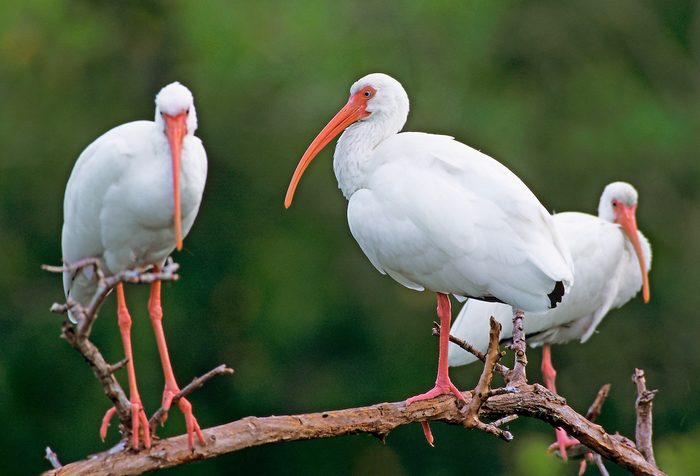
Bird feet tend to have dull, dark colors, but here are a few that flaunt bright hues.
- Snowy egret: Black legs and yellow feet
- Blue-footed booby: You can guess this one!
- Least bittern: Greenish-yellow legs and feet
- Louisiana waterthrush: Bubblegum pink feet
- Blackpoll warbler: Yellow feet
- Horned puffin: Orange feet
- White ibis: Red legs and feet
Why Trust Us
For nearly 30 years, Birds & Blooms, a Trusted Media Brand, has been inspiring readers to have a lifelong love of birding, gardening and nature. We are the #1 bird and garden magazine in North America and a trusted online resource for over 15 million outdoor enthusiasts annually. Our library of thousands of informative articles and how-tos has been written by trusted journalists and fact-checked by bird and garden experts for accuracy. In addition to our staff of experienced gardeners and bird-watchers, we hire individuals who have years of education and hands-on experience with birding, bird feeding, gardening, butterflies, bugs and more. Learn more about Birds & Blooms, our field editor program, and our submission guidelines.
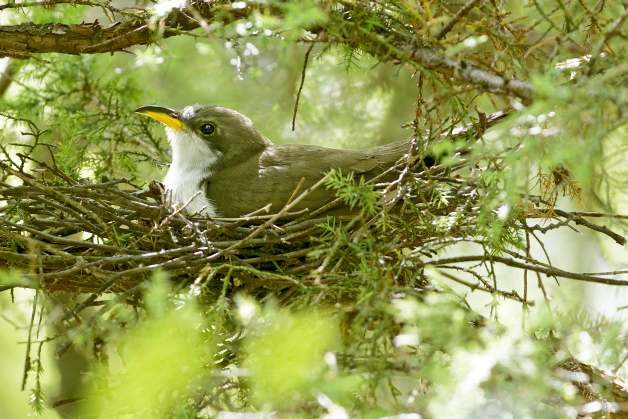
Try your hand at bird landscaping, and you’ll quickly learn that landscaping is for the birds—literally! Planting with birds in mind pays off fast, attracting birds in greater numbers with more variety and longer visits from your feathered friends. It’s easy, too. All it takes is looking at your yard from a bird’s point of view.
You’ll have greater success at attracting your favorite species when you realize two things–finding food and not getting eaten–are the two biggest issues for birds. Food is the first step to winning the hearts of birds, and keeping a feeder makes you feel good, too. To really bring in the birds, you need to make them feel at home in your yard. And the way to do that is by growing plants for nesting birds.
Bird landscaping or birdscaping, as some people call it, is a lot simpler than it sounds. All it takes are some common sense and a few lessons from the very best gardener of all, Mother Nature.
On This Page
Bird Landscaping Basics
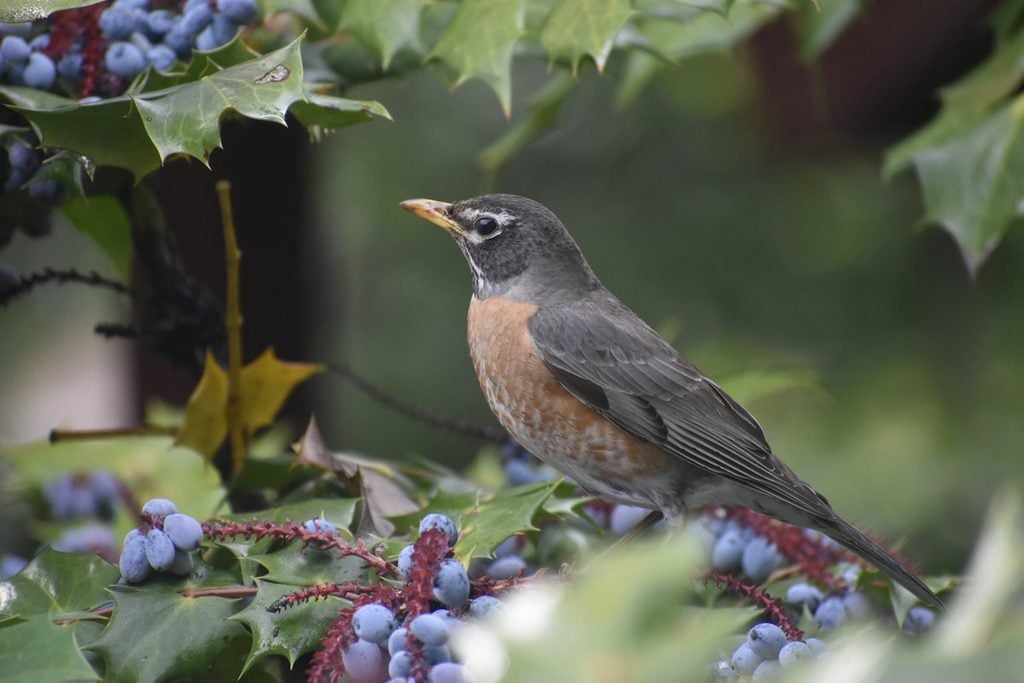
Imitate natural wild areas, and you’ve got it made. You could just let your whole backyard go wild; birds would heartily approve. But most of us like to keep some sense of order, so try these bird landscaping tricks to keep both you and your feathered friends happy.
- Plant shrubs for nesting birds in groups of three or more, to build larger areas of cover.
- Spread a thick layer of mulch beneath and between shrubs. Instantly, you’ve made an inviting foraging area for towhees, robins, native sparrows and juncos.
- Add a hedge along a boundary or your privacy fence. Include thorny shrubs, such as roses or flowering quince, to provide tempting nesting places for brown thrashers, gray catbirds, cardinals and others.
- Plant evergreen shrubs and trees such as holly, rhododendron, and spruce to offer shelter from the weather.
- Vary the height of your flower beds and boost their bird appeal by planting small trees, such as dogwood and redbud, right in the beds.
The Perfect Plants for Your Bird Landscape
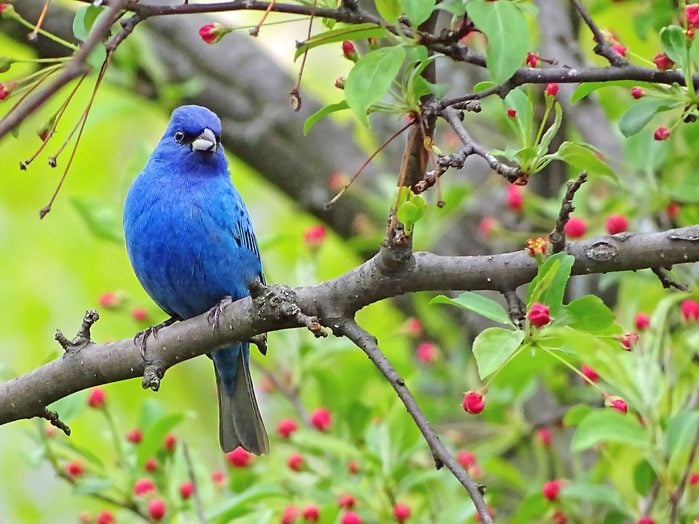
You can find hundreds of specific plants to attract birds, but how do you get started finding them? This general list will steer you in the right direction.
- Native trees or shrubs
- Flowering crabapples, hawthorns
- Fruit trees or bushes
- Junipers
- Pines or spruces
- Other flowering trees and shrubs
Trees for Birds That Eat Insects
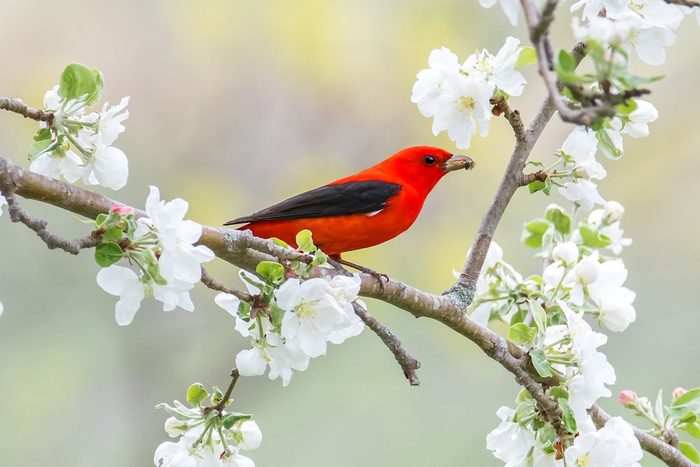
Talk about multitasking—the plants in our yards do it all. They supply vital protective cover, shelter birds in bad weather and serve as nesting places.
And that’s not all. Many plants also serve up enough natural food—seeds, fruit, berries and especially bugs—to keep birds coming back day after day.
Insects are the natural food our feathered friends rely on year-round. A big banquet of them will draw in birds of all kinds, just as feeders do.
To boost your bugs—yep, more insects is a good thing, if you want birds—add spring-flowering trees to your yard. Crabapples and other fruit trees bloom at migration time. That makes them an inviting pit stop for traveling warblers, vireos, gnatcatchers, tanagers, orioles and other birds that recognize the opportunity for an insect feast.
Native Plants for Birds That Eat Caterpillars
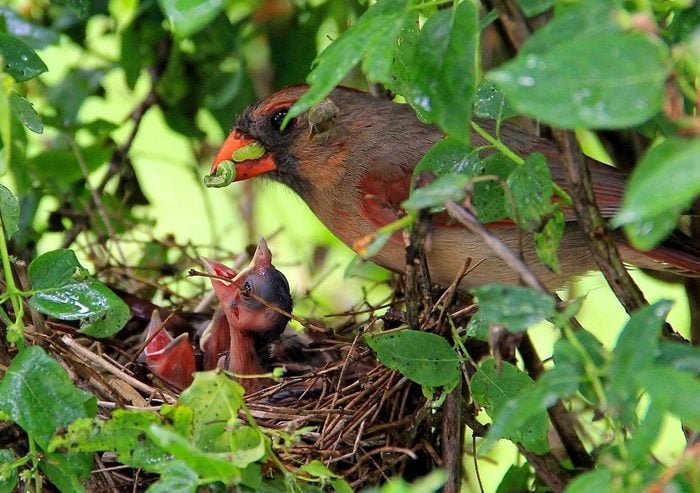
Caterpillars are another can’t-miss menu item for birds. They’re at their peak during nesting season, just in time to stuff down a bunch of gaping beaks. No need to research good plants for caterpillars—just go native. Many native trees, shrubs and other plants serve as hosts for egg-laying butterflies or moths, as well as nurturing a plethora of other insects.
Trees and Bushes for Birds That Eat Berries
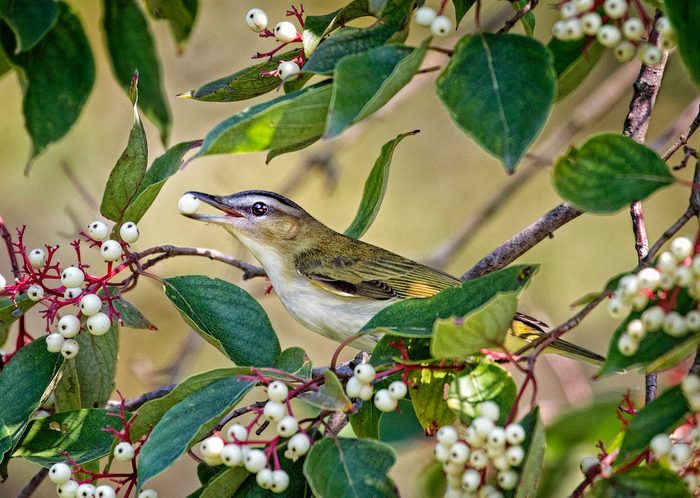
Ask any bird lover what plants are best for nesting birds, and the answer is likely to be berry bushes. A hedge of mixed berry bushes is irresistible to bluebirds, thrashers, catbirds and other friends. Groups of shrubs with just a hop, skip and jump between them are also great.
Birds somehow know when the fruit crop is ready, and it’s quite a thrill when our favorite songbirds start winging their way in from miles around.
Still, it takes only a week or so until the birds have gobbled every berry. The show is over until the next fruit or berry in your yard starts to ripen.
I wouldn’t be without berry bushes or fruit trees in my yard. But I look beyond the harvest, and so do the birds. Any fruit or berry we plant is going to be home to bugs. Even if they escape our notice, birds will find them. Plus, like any plant we find a place for, berry bushes will add to the available cover, and maybe even cradle a cardinal nest come spring.
Bird Landscaping for Predator Protection
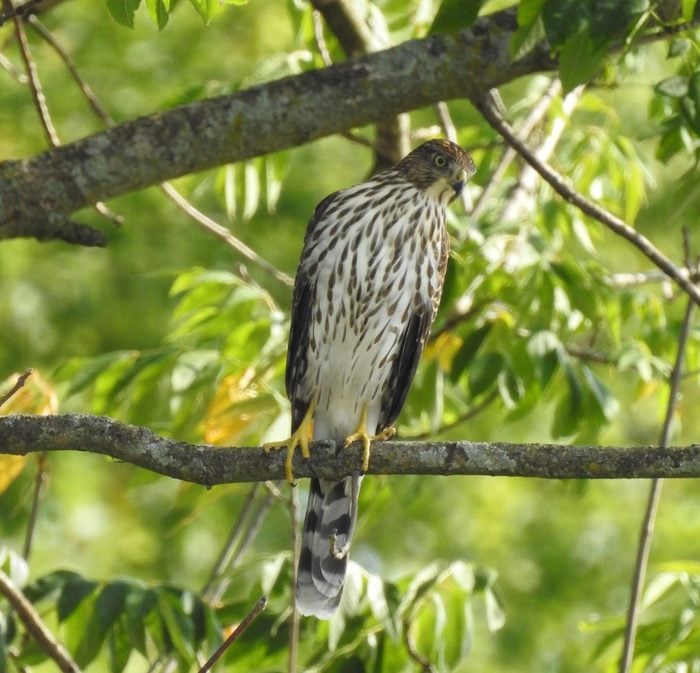
You can learn a lot about planning for birds just by watching them in their natural surroundings. Observe them in your yard, and you’ll see that very few of them spend time out in the open. Most of our friends stay under cover as much as they can to boost their chances of survival. They alight in trees, gather in bushes or scoot through the garden looking for food. The sheltering branches or stems protect them from the hungry eyes of predators.
A stalking cat may rush a robin on the lawn. A hungry hawk may drop from the sky at any moment. Vulnerable nestlings, eggs or even parent birds on the nest may be the target of a prowling raccoon or slithering snake.
So think like a wary bird and set up stepping-stones of shrubs, trees, grasses and flower beds. Go horizontal with corridors of plants so birds can move easily about your yard.
But think vertically, too, because birds move up and down as well as sideways. You can shoehorn in a surprising amount of cover by layering small trees, shrubs, ferns and ground covers near big trees, and by adding an arbor or trellises for vines and roses. Your backyard will soon look like an oasis, especially from the air.
Check out the best plants that attract birds in all seasons.
Skip Pesticides
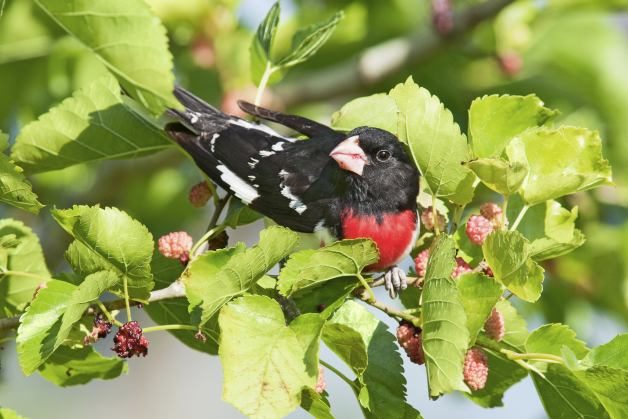
Of course, you’ll want to avoid pesticides as much as possible in your bird paradise. Just think of those pesky bugs as bird food, and be patient until the troops arrive. Chickadees, wrens and vireos will help you out with aphids. Cardinals and rose-breasted grosbeaks snap up potato beetles. And starlings are your best friends when it comes to Japanese beetles: They’re searching for grubs when they waddle about, stabbing the ground.
Don’t Clean Up Too Much
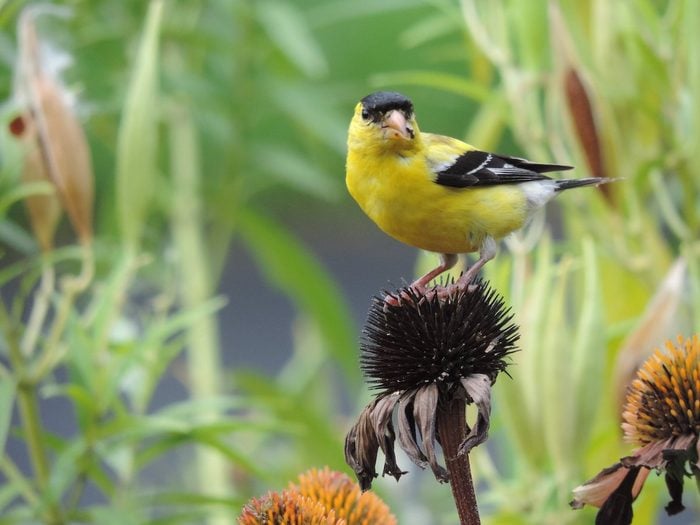
While most gardeners strive for neatness, birds like messy surroundings, so bird landscaping focuses on finding a happy medium—a natural look that will coax birds into lingering and possibly even nesting. Let perennials, shrubs and other plants knit together, instead of keeping bare space around every plant. Allow the dead leaves to lie beneath shrubs and hedges as an insect-rich mulch for gray catbirds, thrashers, wrens and other friends to investigate.
Hold off on cutting back flower beds until spring so goldfinches, titmice, doves, quail and other birds can shelter in them when searching for seeds and insects in winter. Instead of getting out the clippers every few months, learn to love the natural look of a free-form hedge. Birds will appreciate it. And you’ll appreciate the birds bringing life to your yard, every season of the year.
Why Trust Us
For nearly 30 years, Birds & Blooms, a Trusted Media Brand, has been inspiring readers to have a lifelong love of birding, gardening and nature. We are the #1 bird and garden magazine in North America and a trusted online resource for over 15 million outdoor enthusiasts annually. Our library of thousands of informative articles and how-tos has been written by trusted journalists and fact-checked by bird and garden experts for accuracy. In addition to our staff of experienced gardeners and bird-watchers, we hire individuals who have years of education and hands-on experience with birding, bird feeding, gardening, butterflies, bugs and more. Learn more about Birds & Blooms, our field editor program, and our submission guidelines.
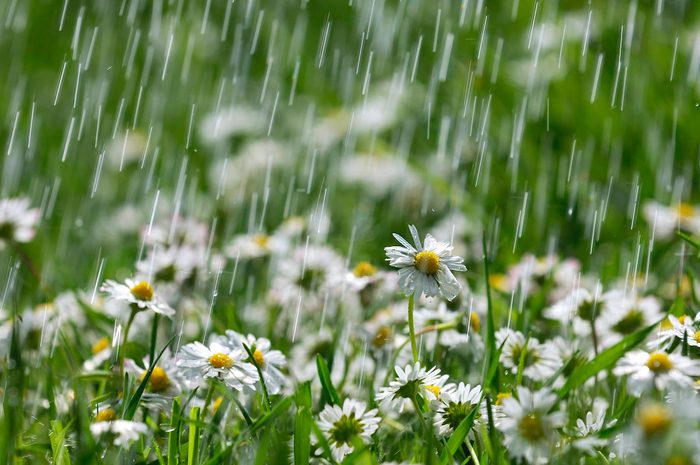
Water—it’s one of the most essential, beneficial and frustrating assets for gardeners throughout the country. At any given time, there seems to be either too much of it or not enough. So what’s the solution? Plant a rain garden!
On This Page
Rain Garden Benefits
No, a rain garden won’t necessarily solve all your planting problems, but it’s one of the most attractive and effective ways to manage inconsistent rainfall in your backyard. The rewards are almost endless: It reduces the risk of flooding and overloading storm sewers, it allows plant roots and soil to filter out impurities before the water goes back into the ground, and it’s just plain good for the environment.
While most trees, grasses and other plants naturally help intercept rainwater, rain gardens can soak up as much as 30 percent more water than conventional lawns. If planned right, they also provide a natural habitat for birds, as well as butterflies and other helpful insects. So start planning your rain garden now, and put rainwater to work for you.
Check out the top 10 water wise plants that will thrive in a dry spell.
Planning Your Rain Garden
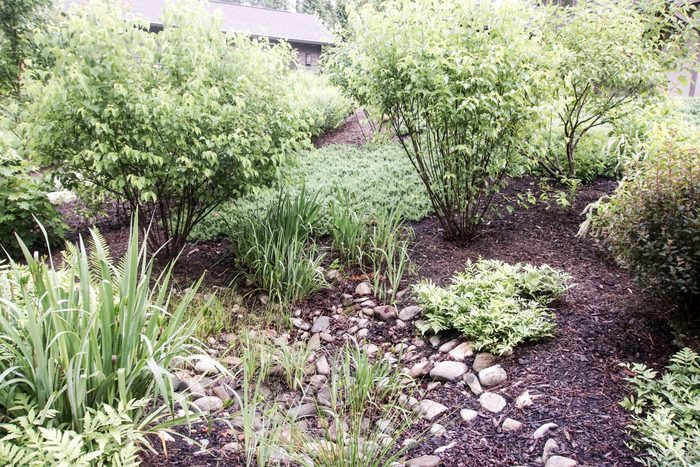
For best results, consider a few things up front. Note your soil type, the slope of the garden area, the distance from the house, the average rainfall for your area and the square footage of hard surfaces such as drives, walks or rooftops where you’re collecting water.
You’ll want to prepare your garden on a slight slope and at least 10 feet away from your house to avoid water collecting near your foundation. Also, avoid planting rain gardens over septic systems and under trees, where increased soil moisture could cause damage.
If possible, design the garden with the longest end perpendicular to the slope, increasing the border available to intercept water runoff. The garden should be about twice as long as it is wide. This provides plenty of room for plants to help slow down water and absorb it, as well as making it easier for you to come up with an attractive layout for the area.
Prepare the Site
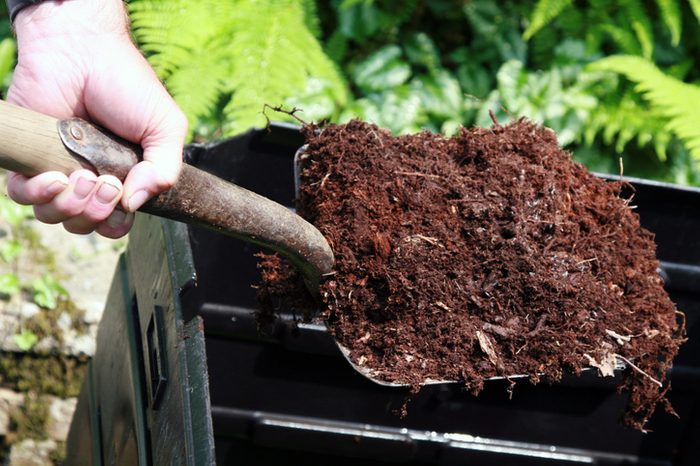
Most rain gardens should be 4 to 8 inches deep, but you’ll need to take the soil type, slope and size of your garden into account. Make sure the garden is level to avoid water pooling on one side.
You may need to move, excavate or add soil to make this happen. It also might help to create a small berm on the downhill edge of the garden to help contain water until it can naturally drain.
Dig several inches of compost or other organic matter into the top 6 to 8 inches of soil before planting. This will improve drainage in heavy soils and increase the water retention of fast-draining soils. This step is really crucial, because natural rainfall supplying water to your garden will often be irregular.
In the end, a well-designed garden will drain within 12 to 48 hours, avoiding standing water. This is important to the health of your plants and to prevent mosquitoes from breeding in your garden.
Psst—check out our guide on how to make compost.
Add Rain Garden Plants
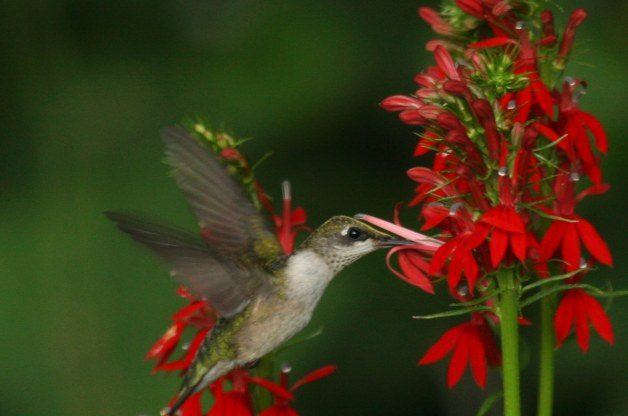
Select plants suited to temporary flooding and drought, since rain gardens are not water gardens, ponds or wetlands. They are designed to capture water during rainfall and quickly drain as plants absorb the moisture and as excess water moves through the garden soil to recharge the groundwater. Ultimately, your goal is to reduce your workload, not increase it.
Begin choosing plants by looking at the native plant species in your area. Plants native to prairies and swamps or other areas subject to flooding and drought are your best bets, but don’t stop there. Also check with nature centers, extension offices and your state department of natural resources to see if they offer regional rain garden suggestions as well.
As you go, use plants with a variety of bloom times for season-long color. Variety is a must. For instance, a mixture of sedges, rushes and other grassy plants make a dramatic backdrop for flowers.
Go lawn free: learn how to plant a prairie garden.
Best Perennials for Rain Gardens
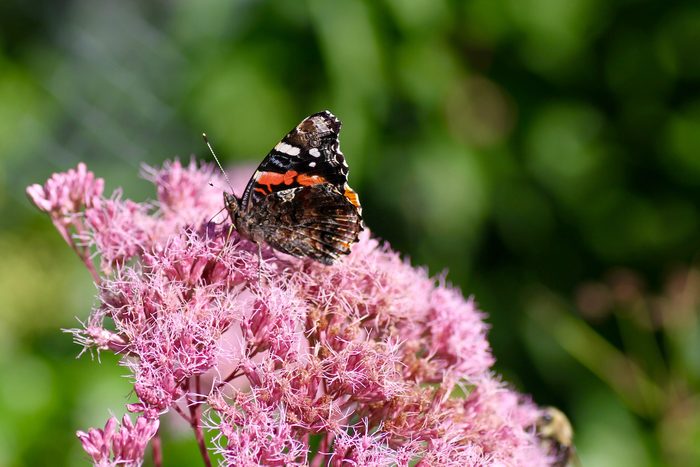
Here some colorful perennials to try:
- Cardinal flower (Lobelia cardinalis)
- Black-eyed Susan (Rudbeckia fulgida)
- Swamp milkweed (Asclepias incarnata)
- Swamp mallow (Hibiscus moscheutos)
- Joe Pye weed (Eupatorium)
- Sedges (Carex)
- Bluestar (Amsonia)
- Turtlehead (Chelone)
Mulch the Soil
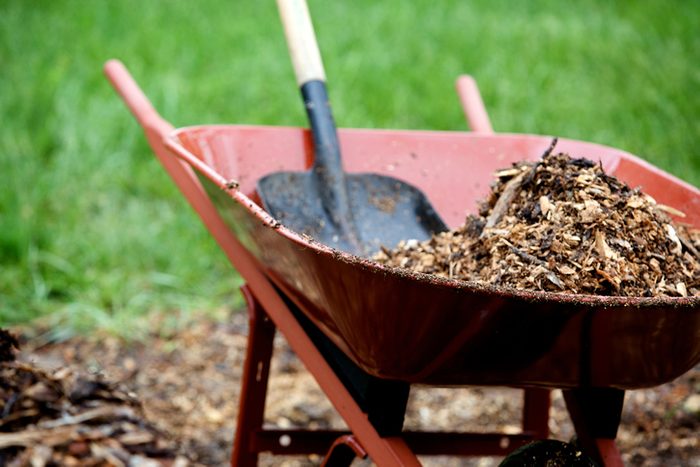
Place moisture lovers in the lowest areas of the garden that tend to stay wetter longer, and plant drought-tolerant species on the sides or edges of the garden.
Once all the plants are in, mulch the garden with twice-shredded bark. This mulch knits together and won’t wash away in the rain. Plus, mulching the soil prevents erosion, conserves moisture during dry spells and suppresses weeds. Be careful not to bury the crowns of the plants, though, because that can lead to rot.
Water Your Rain Garden
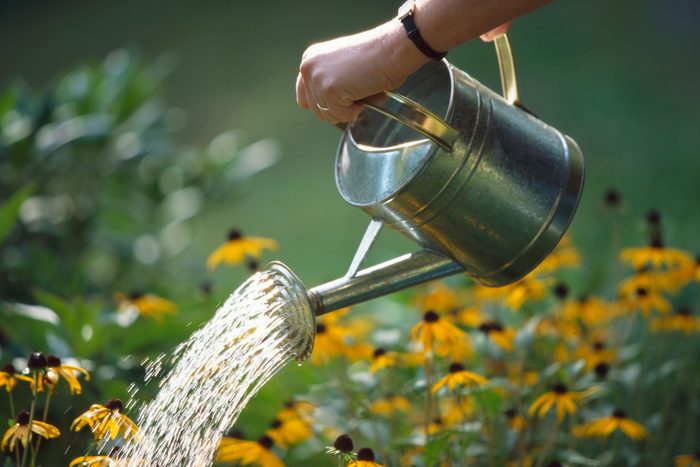
Just because you have a rain garden doesn’t mean you don’t have to water it. Make sure new plantings receive sufficient water, about an inch a week. Adjust the frequency based on the temperature and your soil type. New plantings, even drought-tolerant ones, need regular watering to encourage deep roots that are more efficient at absorbing water.
When is the best time to water plants?
Rain Garden Maintenance
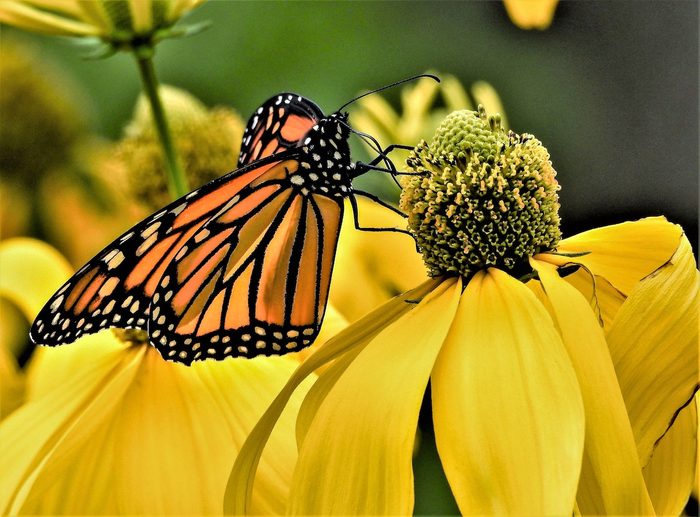
Weed regularly the first few years to allow your desirable plants to get established, fill in and outcompete future weeds. Remove dead growth at the start of each season and cut plants back as new growth begins. For an easy spring cleanup, use a string trimmer or mower you can set higher than the new growth. A hand pruner is best for thicker stems like sunflowers, asters and Joe Pye weed.
It’s not all work and no play, though. Rain gardens are relatively low maintenance once you get them installed and established. So kick back as you enjoy the birds, butterflies and neighbors that visit your garden. You can feel good about doing your part for the environment, one garden at a time.
4 Tips for a Successful Rain Garden
- Do the research and plan. Don’t think you can just put in a rain garden on a whim. It takes careful thought and planning.
- Location does matter. Make sure your garden is at least 10 feet away from the foundation of your house. Don’t plant it under trees, over septic systems or in areas where water might collect.
- Work with your soil. Amend the soil to improve drainage in heavy soils and increase the water retention of porous soils.
- Choose plants carefully. Be sure to pick varieties that tolerate both temporary flooding and drought.
Alternate Ways to Conserve Water in the Garden
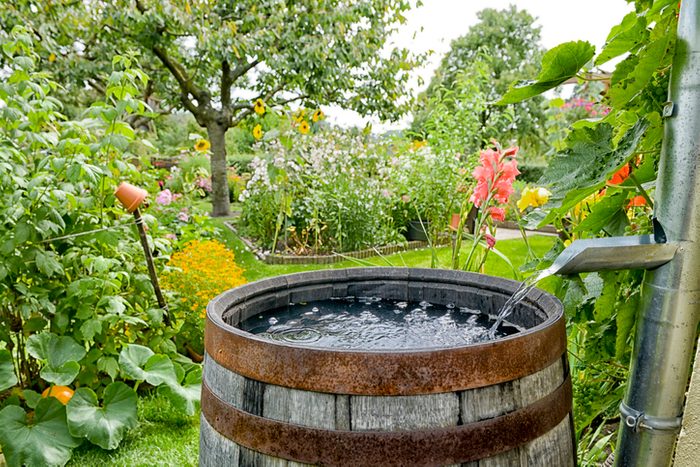
Don’t want to plant a rain garden? Here are some other ideas for conserving water.
- Install rain barrels and cisterns to capture water for use in the landscape
- Use water from dehumidifiers or air conditioners to water container plants
- Use drought-tolerant plants
- Group moisture lovers together
- Mulch soil to conserve moisture
Why Trust Us
For nearly 30 years, Birds & Blooms, a Trusted Media Brand, has been inspiring readers to have a lifelong love of birding, gardening and nature. We are the #1 bird and garden magazine in North America and a trusted online resource for over 15 million outdoor enthusiasts annually. Our library of thousands of informative articles and how-tos has been written by trusted journalists and fact-checked by bird and garden experts for accuracy. In addition to our staff of experienced gardeners and bird-watchers, we hire individuals who have years of education and hands-on experience with birding, bird feeding, gardening, butterflies, bugs and more. Learn more about Birds & Blooms, our field editor program, and our submission guidelines.
Sources
Melinda Myers, official gardening expert for Birds & Blooms
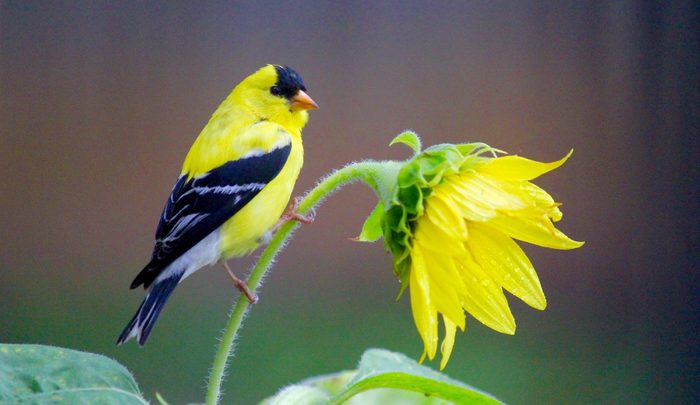
Whether you’re already a dedicated caretaker of backyard feeders or brand-new to birding, it’s always a good idea to kick it up a notch! Native plants that allow you to harvest seeds will attract more birds to your backyard. After all, plants have a lot more to offer than just beautiful flowers. Why not get the most out of your garden by growing birdseed plants to feed your feathered friends?
“Anybody, anywhere they live, can support the birds they love by growing native plants,” says Tod Winston, program manager for the National Audubon Society’s Plants for Birds program.
Check out the National Audubon Society’s Native Plants Database or consult local native plant nurseries to find the best picks for your zone and region.
“The more people who plant native plants in their yard, the more resilient birds are going to be in the face of climate change and in the face of continuing loss of habitat,” Tod says. He adds that nearly 41 percent of all migratory songbird populations in North America are declining.
Sunflowers are an easy-care option that will work in almost every garden. If you’re seeking some variety to beautify your backyard, consider planting other native birdseed plants from the Aster family. Try coneflowers, tickseed and black- and brown-eyed Susans.
On This Page
Sunflowers
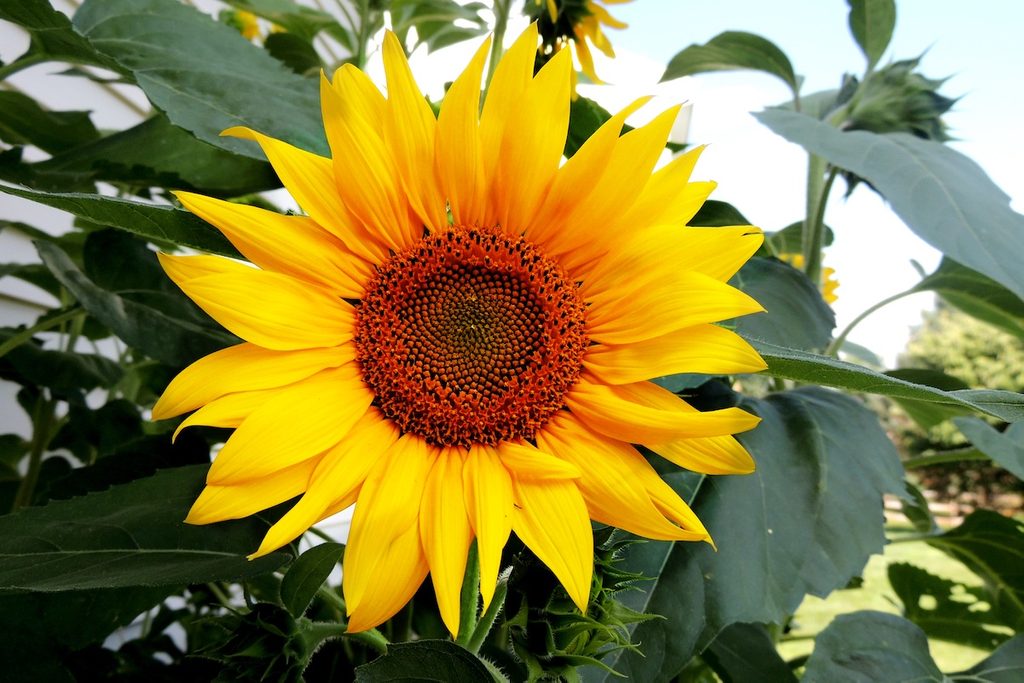
Helianthus annuus, annual
You can’t expect to grow your own birdseed without this classic bird magnet. There are plenty of varieties to choose from, including cultivars that range from 2 to 15 feet tall and colors from yellow to red.
Sunflowers are simple—it doesn’t take much for their seeds to take root. Plant your sunflower seeds in late spring, provide them with plenty of sun and a spot in a patio pot, raised bed or garden, and you’ll soon have a crop of flourishing flowers.
Check out the top 10 sunny sunflower varieties.
Sunflowers benefit many seed-eating birds, including cardinals, grosbeaks, finches, sparrows and more. And their compound flower heads are packed with pollen, so hummingbirds may stop by. These bright beauties also host more than 70 species of native moth and butterfly caterpillars.
That’s a big deal because one nest of Carolina chickadee chicks may eat up to 9,000 caterpillars before fledging. Plus, 90 percent of land birds feed insects to chicks, so it’s important to protect those local populations.
Migrating birds also love the seeds, because they’re high-fat fuel for their journeys south.
Black-eyed Susan
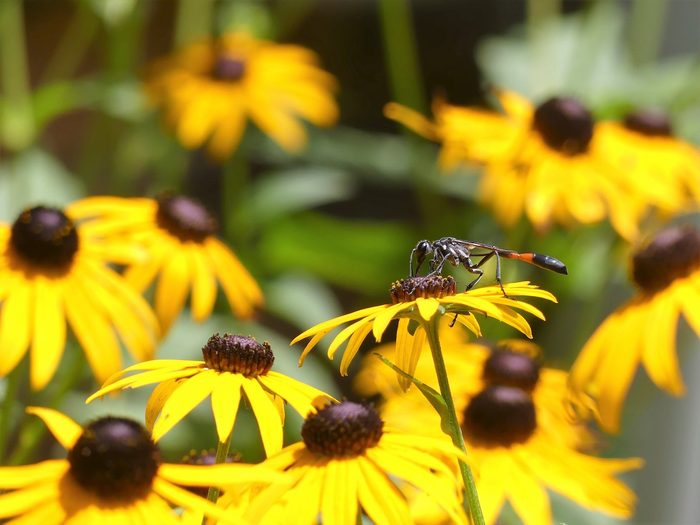
Rudbeckia, Zones 3 to 9
This is another garden classic that birds adore. The traditional black-eyed Susan has dark centers and bright-yellow flowers, but now there are even more varieties to choose from. Grow in full sun to light shade for blooms in summer through autumn.
Blazing Star
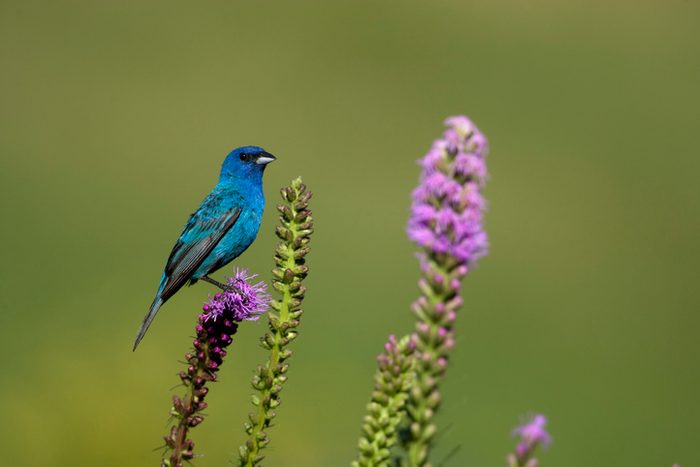
Liatris species, Zones 3 to 9
Many gardeners know these birdseed plants as gayfeather. Don’t be surprised when you see an American goldfinch gripping the purple spikes of the flower head. Blazing star grows up to 5 feet in full to partial sun and blooms in summer.
Coreopsis
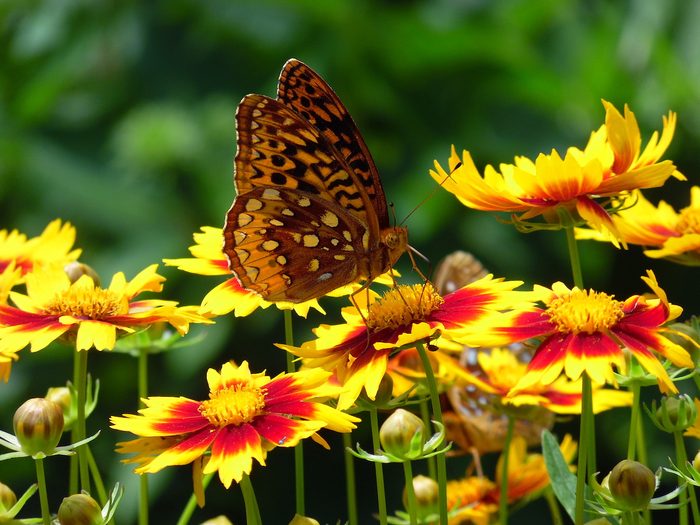
Coreopsis, hardiness varies by variety
It’s not hard to find an annual or perennial coreopsis (also called tickseed) that will flourish in your yard. Plant in full sun and resist the urge to overwater, as it’s a drought-tolerant superstar that blooms in late spring through late summer.
Cosmos
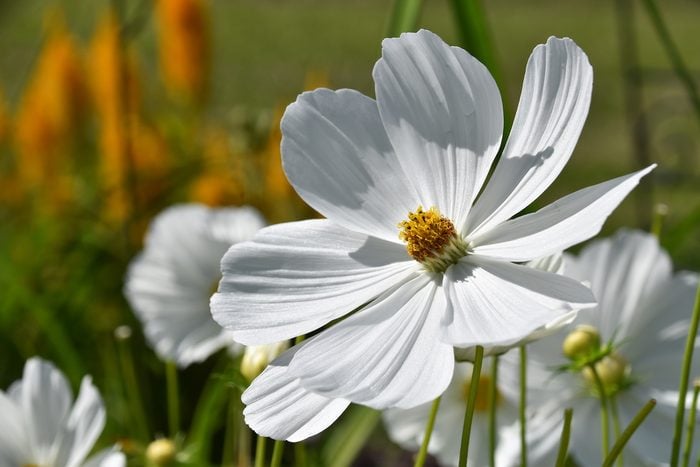
Cosmos bipinnatus, annual
With its gorgeous daisy-shaped blooms, this low-maintenance beauty seems too good to be true. Grow single or double blooms in full sun, and you’ll have cosmos flowers (and seeds to offer feathered friends) from summer through late fall.
Mexican Sunflower
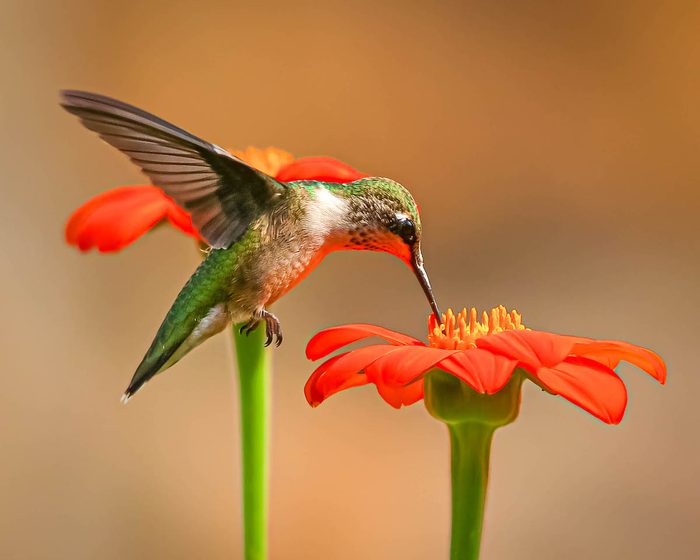
Tithonia rotundifolia, annual
The vibrant, orange flower heads of Mexican sunflower will make a bold statement in any garden. Often mistaken for a zinnia, this sun- and heat-loving plant definitely holds its own when it comes to attracting birds.
Purple Coneflower
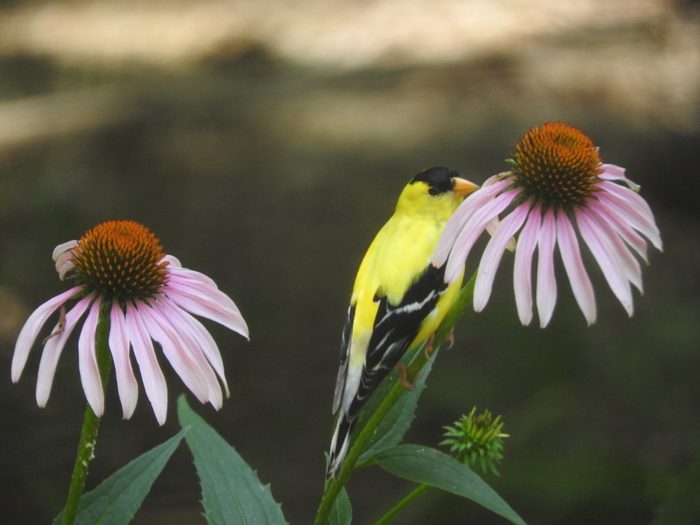
Echinacea purpurea, Zones 3 to 9
Birds will feast on this backyard favorite. New coneflower varieties offer a wide range of colors, including purple, pink, white, yellow and orange. Plant in full sun for gorgeous blooms from midsummer to early fall.
Purple Majesty Millet
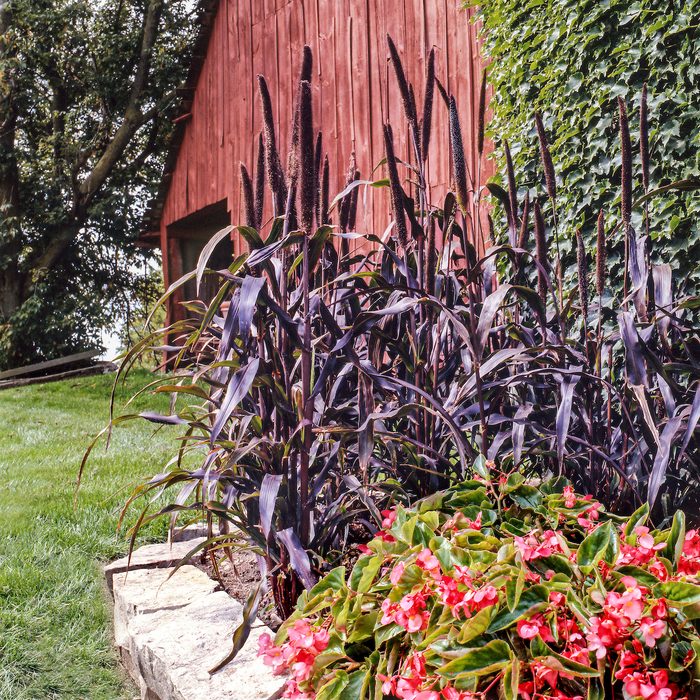
Pennisetum glaucum ‘Purple Majesty’, annual
It’s not as familiar to gardeners as other birdseed plants on this list, but your birds will catch on fast! The plant itself is 4 to 5 feet tall, while the flower stalk offers another foot of delectable goodies for birds. Grow in sun or shade to get amazing foliage from spring to fall.
Safflower
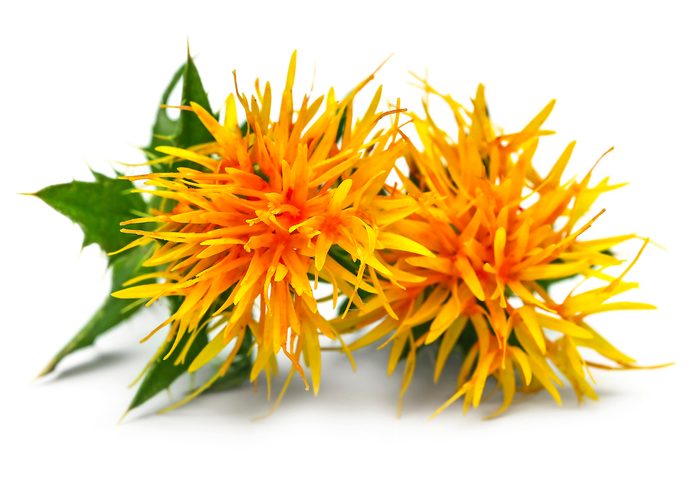
Carthamus tinctorius, annual
Safflower seed is easy to grow and the birds love it! Even if the birds don’t plant it for you, all you need to do is poke some kernels from your seed mix about an inch into the ground in spring. Safflower leaves get spiny as the plant matures. To save your fingers, grow the plant in a casual bed with blue larkspur, bachelor’s buttons, cosmos, marigolds and other easy-care, self-sowing annuals where it can take care of itself.
Even a small planting can keep cardinals, jays, chickadees, titmice, finches, native sparrows and doves investigating all fall and winter.
Why Trust Us
For nearly 30 years, Birds & Blooms, a Trusted Media Brand, has been inspiring readers to have a lifelong love of birding, gardening and nature. We are the #1 bird and garden magazine in North America and a trusted online resource for over 15 million outdoor enthusiasts annually. Our library of thousands of informative articles and how-tos has been written by trusted journalists and fact-checked by bird and garden experts for accuracy. In addition to our staff of experienced gardeners and bird-watchers, we hire individuals who have years of education and hands-on experience with birding, bird feeding, gardening, butterflies, bugs and more. Learn more about Birds & Blooms, our field editor program, and our submission guidelines.
Sources
- The National Audubon Society
- The Cornell Lab of Ornithology, NestWatch
- NATURE documentary series, PBS.org
- Doug Tallamy, professor of entomology and wildlife ecology at the University of Delaware
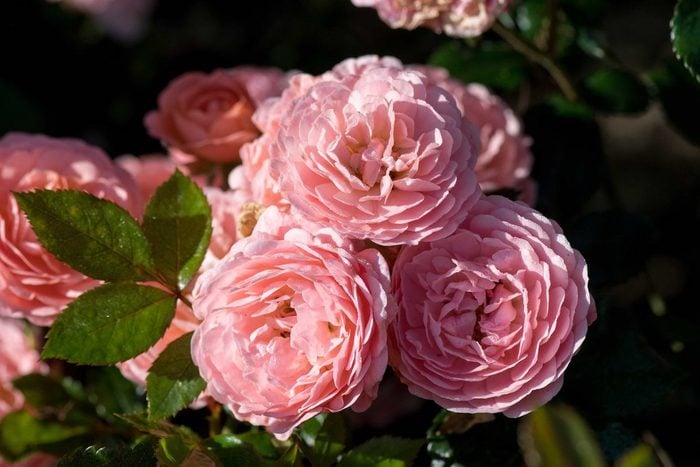
Roses used to be known for requiring so much specialized care that they needed their own section of garden. But today’s breeders are creating roses that blend into our lives and gardens—and Drift roses may become your new favorite.
Discover the best types of roses for every garden.
On This Page
Drift Rose Varieties
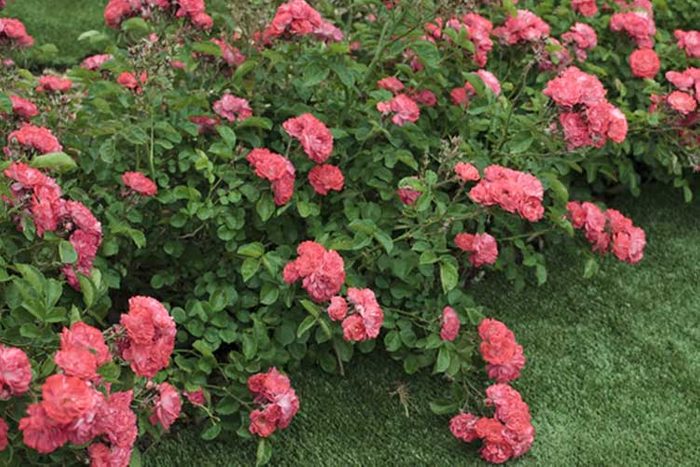
Drift roses arose from a cross between larger ground-cover roses and miniature roses, creating a hearty combination. There are 11 varieties in the Drift series, ranging from white and yellow to apricot, peach, coral and deep rose.
The 1 1/2-inch-wide flowers are plentiful and repeatedly bloom throughout the season. Apricot Drift and Sweet Drift roses are tightly double, resembling a Damask rose.
Discover surprising facts about roses.
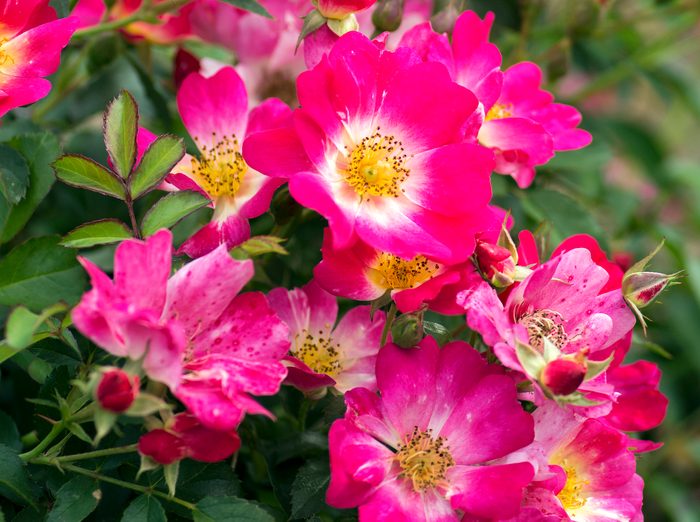
Pink Drift has fewer petals and is more open, revealing gold stamens and a white eye. If you can’t resist a fragrant rose, Peach Drift boasts a floral, honey scent. For a bit of whimsical fun, go with Popcorn Drift for its buttery white and yellow blooms.
The series is listed as hardy in USDA Zones 4 to 11—except for Lemon Drift, which is hardy from 5 to 11—and most are considered disease-resistant.
Learn everything you need to know about Knock Out roses.
Drift Rose Planting and General Care
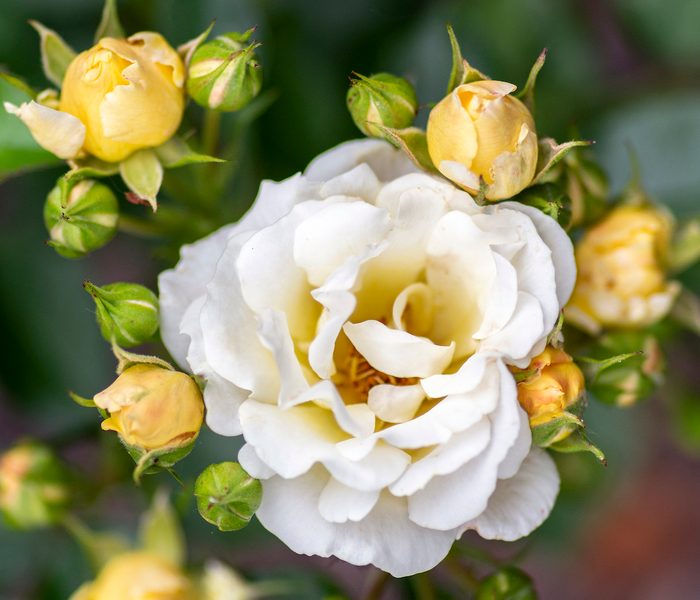
Each Drift rose thrives in six to eight hours of direct sun in moist, well-draining soil.
With one annual pruning, these roses can stay about 1½ to 2 feet high and 2 to 3 feet wide. Simply trim them to about 6 to 8 inches tall before leaves emerge in spring. Also, remove any dead or crossing branches to improve growth and airflow.
Deadheading is not necessary, but you can remove spent blooms if you prefer a tidier look. Without trimming, expect new blooms every five to six weeks until frost.
Only a little is needed in the way of fertilizer too. If desired, the breeders recommend waiting until the rose is established in your garden and has bloomed once. To prevent burning the roots, water the soil first, then add fertilizer and water again. It’s important to stop fertilizing in late summer to allow your rose to slow its growth and prepare for winter.
Floribunda rose vs grandiflora rose: what’s the difference?
Watering Drift Roses
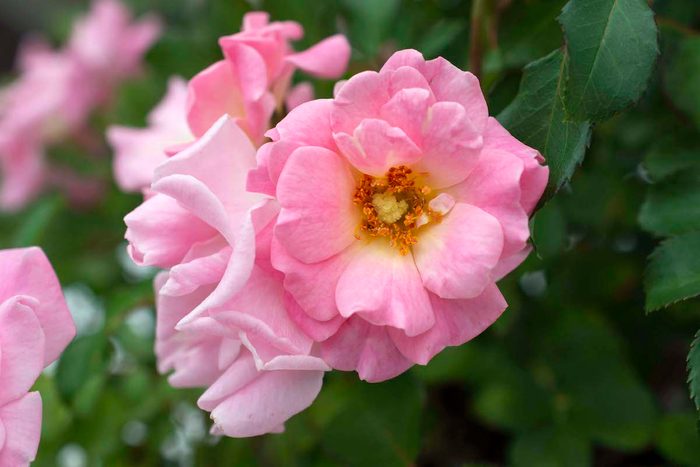
Once established, in-ground plants should do well with a deep watering once a week. Container plants may need watering twice a week or more in hot weather. Give extra water during hot and dry periods, especially during the first season. Watering at the base of the plant rather than overhead watering with a hose or sprinkler promotes healthy growth and can prevent some diseases.
Check out the top 10 fragrant roses to perfume your garden.
Drift Rose Pests and Diseases
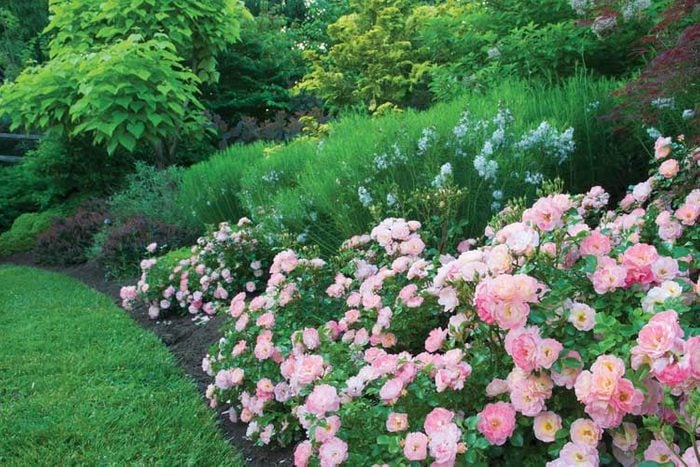
While most of the Drift series of roses has notable disease resistance to black spot and powdery mildew, some sources report occasional incidence of leaf spot, canker, and blight. Pests to look out for include bud borers, spider mites, and Japanese beetles.
Stress, crowded planting, overhead watering, and over-fertilizing, especially with high nitrogen formulations can exacerbate or invite these issues.
Watch for signs of rose rosette disease, which can affect any type of rose. Symptoms include newly thorny canes, persistent red stems and distorted buds. If confirmed, destroy and remove the plant.
Learn how to get rid of rose chafer beetles.
Winter Care in Colder Climates
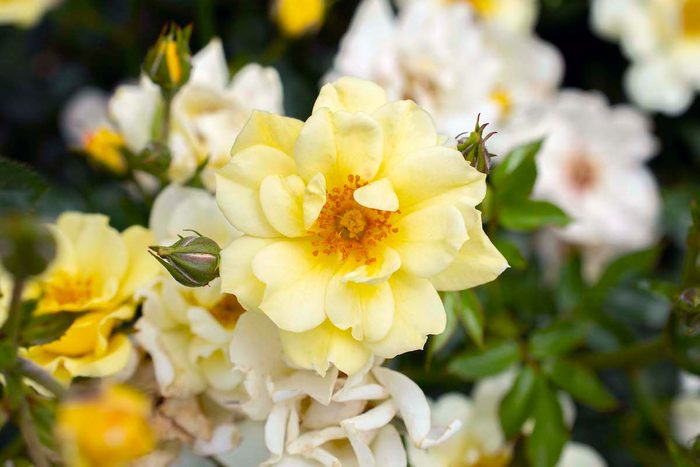
If you’re in the colder portions of Drift roses’ hardiness range, you can give them some extra protection to help during winter. Apply a mulch of 2 to 3 inches of leaves or pine boughs around the base of the plants to help insulate them after the ground freezes. In windy locations, you can wrap your roses in burlap. Remove mulch and burlap in spring at pruning time.
Any Drift roses in containers also need special care because their roots are more vulnerable to the winter’s drying winds and freezing temperatures. Let them go through the first few frost events outside. Then water lightly and bring them inside to a cool, dark area like an unheated garage (or sink the pot, if winter tolerant, into a vacant spot in the garden). Water only enough during the winter to prevent drying out completely, and put them outside in early spring.
Next, find out why roses have thorns (and hips)?
Why Trust Us
For nearly 30 years, Birds & Blooms, a Trusted Media Brand, has been inspiring readers to have a lifelong love of birding, gardening and nature. We are the #1 bird and garden magazine in North America and a trusted online resource for over 15 million outdoor enthusiasts annually. Our library of thousands of informative articles and how-tos has been written by trusted journalists and fact-checked by bird and garden experts for accuracy. In addition to our staff of experienced gardeners and bird-watchers, we hire individuals who have years of education and hands-on experience with birding, bird feeding, gardening, butterflies, bugs and more. Learn more about Birds & Blooms, our field editor program, and our submission guidelines.